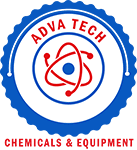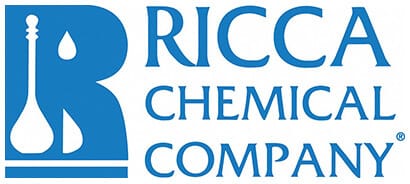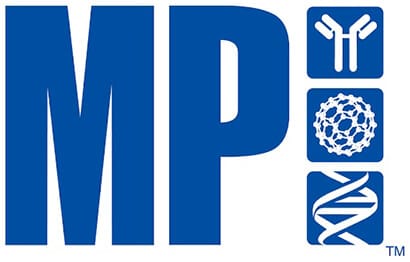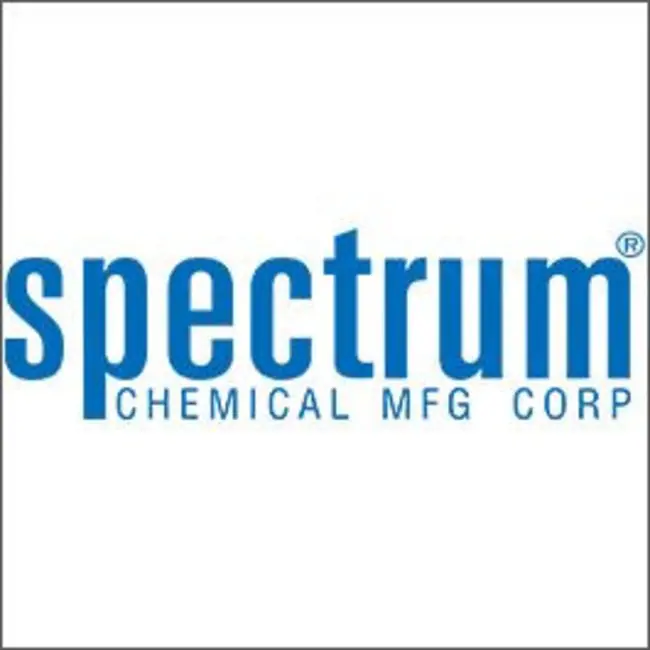Showing 27401–27450 of 33980 results
-
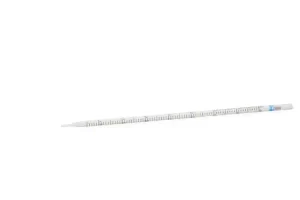
Thermo Scientific™ Nunc™ Serological Pipettes
$73.13 Add to cart View Product DetailsStringent quality specifications, and convenient features make Thermo Scientific™ Nunc™ Serological Pipettes a great choice for daily lab work. Bold, clear bi-directional graduations make it easy-to-read fluid volumes and dispensing amounts. Choose from a broad selection of sizes and packaging options.
nn
Product Details:-
- Wide Range of Volumes and Packaging Option
n
-
- Color-coded pipettes and packaging for convenient volume selection
n
-
- Individually packed pipettes in either paper/plastic or plastic peel for high sterility assurance
n
-
- Reduce packaging waste with bulk packed options
Certified Calibration of Accuracy and Precise Graduations-
- Ensures dispensing accuracy +/-2% for 1mL and 2 mL and +/-1% for 5 mL, 10 mL, 25 mL, 50 mL at full volume
n
Clear, Bold, Bi-directional Graduations-
- High contrast graduations for easy-to-read volumes
n
-
- Reverse graduations aid in determining dispensing volume
n
Negative Graduations-
- Increase pipette capacity, and accommodates additional volumes
n
Filter Plug-
- Prevent aerosol or liquid contamination of the pipetting device while further reducing sample-to-sample contamination risks
n
Specifications:
-
- Material: Ultra clear, 100% virgin polystyrene for maximum clarity
n
-
- Contaminant Free: RNase/DNase free, Human DNA free, Non-Cytotoxic, Non-Pyrogenic
n
-
- Sterility: E-Beam irradiation to SAL of 10-6
n
-
- Shelf Life: 5 years from Manufacturing Date
n
Product Testing-
- Certificate of Quality
n
-
-
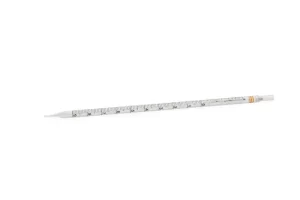
Thermo Scientific™ Nunc™ Serological Pipettes SKU: 170356n
$88.30 Add to cart View Product DetailsStringent quality specifications, and convenient features make Thermo Scientific™ Nunc™ Serological Pipettes a great choice for daily lab work. Bold, clear bi-directional graduations make it easy-to-read fluid volumes and dispensing amounts. Choose from a broad selection of sizes and packaging options.
Product Details:-
- Wide Range of Volumes and Packaging Option
n
-
- Color-coded pipettes and packaging for convenient volume selection
n
-
- Individually packed pipettes in either paper/plastic or plastic peel for high sterility assurance
n
-
- Reduce packaging waste with bulk packed options
n
Certified Calibration of Accuracy and Precise Graduations-
- Ensures dispensing accuracy +/-2% for 1mL and 2 mL and +/-1% for 5 mL, 10 mL, 25 mL, 50 mL at full volume
n
Clear, Bold, Bi-directional Graduations-
- High contrast graduations for easy-to-read volumes
n
-
- Reverse graduations aid in determining dispensing volume
n
Negative Graduations-
- Increase pipette capacity, and accommodates additional volumes
n
Filter Plug-
- Prevent aerosol or liquid contamination of the pipetting device while further reducing sample-to-sample contamination risks
n
Specifications:
-
- Material: Ultra clear, 100% virgin polystyrene for maximum clarity
n
-
- Contaminant Free: RNase/DNase free, Human DNA free, Non-Cytotoxic, Non-Pyrogenic
n
-
- Sterility: E-Beam irradiation to SAL of 10-6
n
-
- Shelf Life: 5 years from Manufacturing Date
n
Product Testing
-
- Certificate of Quality
n
-
-
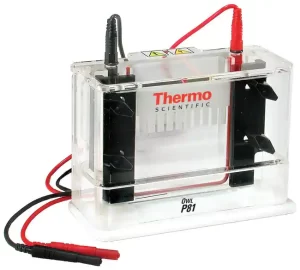
Thermo Scientific™ Owl™ P81 Single-Sided Vertical Electrophoresis System, 10 x 10cm gel size, 150mL buffer volume
$832.08 Add to cart View Product DetailsPerform quick protein runs with the economical and simple, yet rugged Thermo Scientific™ Owl™ P81 Single-Sided Vertical Electrophoresis System.
Features:
- Upper buffer chamber extends the length of the gel to distribute heat evenly across the entire gel surface
- Side clamps press glass plates against silicone gasket to provide uniform pressure and form a leakproof seal resulting in flat, even banding patterns
- Notched alumina ceramic plate (included) may be used in front of notched glass for cooler, faster runs
Includes:
- Upper and lower buffer chambers
- Thermo Scientific™ SuperSafe™ lid with attached power supply leads
- Blank glass plate
- Notched glass plate
- Notched alumina plate
- Two combs (10 well, 0.8mm thick)
- Spacer set (0.8mm thick)
-
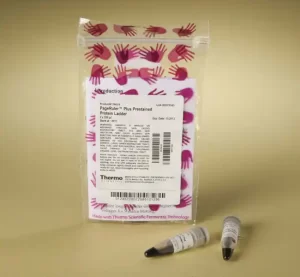
Thermo Scientific™ PageRuler™ Plus Prestained Protein Ladder, 10 to 250 kDa- SKU: 26619
$212.75 Add to cart View Product DetailsThis prestained protein MW marker is designed for monitoring the progress of SDS-polyacrylamide gel electrophoresis, for assessing transfer efficiency onto PVDF, nylon and nitrocellulose membranes, and for estimating the approximate size of separated proteins that have been made visible with gel stains or Western blot detection reagents. A blue chromophore is bound to all proteins, except proteins of two reference bands of 70kDa and 25kDa that are colored with an orange dye and one green reference band of 10kDa. PageRuler Plus Prestained Protein Ladder is ready to use: no heating, further dilution or addition of a reducing agent is required before loading onto a gel.nnHighlights:n
-
- Size range – nine proteins spanning 10 to 250kDa
-
- Ready-to-use – supplied in a loading buffer for direct loading on gels; no need to boil
-
- Sharp bands – color-coded bands of similar intesity for easy visualization
-
- Quality tested – each lot evaluated by SDS-PAGE and Western blotting
-
- Bright reference bands – orange at 70 and 25kDa, and green at 10kDa
-
- Membrane-compatible – colored bands transfer to membranes for Western blotting
Includes:nnDye-stained proteins in 62.5mM Tris-H3PO4 (pH 7.5 at 25°C), 1mM EDTA, 2% SDS, 10mM DTT, 1mM NaN3 and 33% glycerol.
-
-
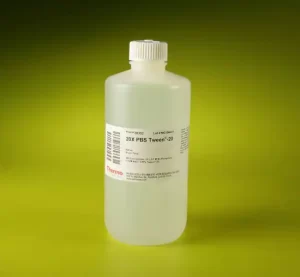
Thermo Scientific™ Pierce™ 20X PBS Tween™ 20 Buffer SKU: 28352
$139.15 Add to cart View Product DetailsOur variety of Pierce Concentrated Buffer stock solutions are ready to use without having to weigh and dissolve dry ingredients or adjust the pH with concentrated acid or base. Simply dilute the liquid stock solution with pure water and proceed with your experiment.
nBenefits of using Pierce Concentrated Buffer stock solutions include:
• Convenient—no weighing, no pH adjustment, no need to stock individual components
• Improved accuracy—ready-to-use formula, easily diluted without weighing chemical components
• Consistent quality—our quality control ensures that every prep will yield the same, consistent buffer
20X PBS Tween-20 can be used to prepare PBS-Tween (PBS-T) wash buffers for ELISA, western, and other immunoassays, as well as blocking buffer for plate-based assays. When diluted to 1X with water, 20X PBS Tween-20 makes 10 mM sodium phosphate, 0.15 M NaCl, 0.05% Tween™ 20 buffer at pH 7.5.
20X TBS Tween-20 (Tris-buffered saline with Tween™ 20 detergent) can be used to prepare TBS-Tween (TBS-T) wash buffers or blocking buffer diluent for applications such as ELISA, western blotting, and other immunoassays. When diluted 20-fold in water, a TBS Tween-20 buffer containing 25 mM Tris, 0.15 M NaCl, 0.05% Tween-20 at pH 7.5 is ready for use.
20X Tris-Buffered Saline (TBS) is a stock solution for preparing Tris-NaCl buffer for use as a wash buffer and antibody diluent for ELISA, western blotting, and other immunoassays. 20X Tris Buffered Saline (TBS) makes 25 mM Tris, 0.15 M NaCl with pH 7.2 to 7.5 when diluted to 1X with water.
20X Phosphate-Buffered Saline (PBS) is ideal for preparing PBS buffers for use in crosslinking, biotinylation, and fluorescent labeling reactions requiring an amine-free buffer. When diluted 20-fold in water, the solution yields 10 mM sodium phosphate, 0.15 M NaCl at pH 7.5.
10X Tris-Glycine-SDS Buffer makes 0.025 M Tris, 0.192M glycine, 0.1% sodium dodecyl sulfate (SDS) at pH 8.5 when diluted to 1X with water.
20X Borate Buffer is ideal for preparing sodium borate buffer solutions for use in protein modification procedures requiring amine-free buffer at an alkaline pH. 20X Borate Buffer makes 50 mM borate at pH 8.5 when diluted to 1X with water.
20X Modified Dulbecco’s PBS is used for preparing physiological Na- and K-phosphate buffered saline (D-PBS) used for wash buffers and antibody diluents in immunoassays like ELISA and western blot. 20X Modified Dulbecco’s PBS makes 8 mM sodium phosphate, 2 mM potassium phosphate, 0.14 M NaCl, 10 mM KCl, pH 7.4 when diluted to 1X with water.
10X Tris-Glycine Buffer is a space-saving stock solution that is ideal for quickly preparing standard Tris-glycine (pH 8.5) transfer buffer used for western blotting using Tris-glycine gel electrophoresis. When diluted 10-fold in water or 20% methanol, the solution yields 0.025 M Tris, 0.192 M glycine at pH 8.5.
10X TBE Buffer stock solution is ideal for casting and preparing Tris-borate-EDTA (TBE) running buffer used for agarose and polyacrylamide gel electrophoresis of nucleic acids. When diluted to 1X, the TBE Buffer contains 0.089 M Tris, 0.089 M borate, 2 mM EDTA with pH 8.2 to 8.4.
20X Modified Dulbecco’s PBS Tween-20 will make physiological sodium- and potassium-phosphate buffered saline (D-PBS) to be used as a wash buffer for ELISA, western, and other immunoassays or as diluent or blocking buffer for plate-based assays. 20X Modified Dulbecco’s PBS Tween-20 (D-PBS-T) makes 8 mM sodium phosphate, 2 mM potassium phosphate, 0.14 M NaCl, 10 mM KCl, 0.05% Tween™ 20 at pH 7.4 when diluted to 1X with water.
20X TAE Buffer is a space-saving stock solution that is ideal for casting and preparing Tris-acetate EDTA (TAE) running buffer for agarose gel electrophoresis of nucleic acids. When diluted to 1X with water, a 0.04 M Tris, 0.04 M acetate, 1 mM EDTA buffer at pH 8.2 to 8.4 is ready for use. -
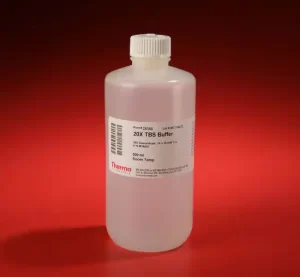
Thermo Scientific™ Pierce™ 20X TBS Buffer SKU: 28358
$138.00 Add to cart View Product DetailsOur variety of Pierce Concentrated Buffer stock solutions are ready to use without having to weigh and dissolve dry ingredients or adjust the pH with concentrated acid or base. Simply dilute the liquid stock solution with pure water and proceed with your experiment.
nBenefits of using Pierce Concentrated Buffer stock solutions include:
• Convenient—no weighing, no pH adjustment, no need to stock individual components
• Improved accuracy—ready-to-use formula, easily diluted without weighing chemical components
• Consistent quality—our quality control ensures that every prep will yield the same, consistent buffer
20X PBS Tween-20 can be used to prepare PBS-Tween (PBS-T) wash buffers for ELISA, western, and other immunoassays, as well as blocking buffer for plate-based assays. When diluted to 1X with water, 20X PBS Tween-20 makes 10 mM sodium phosphate, 0.15 M NaCl, 0.05% Tween™ 20 buffer at pH 7.5.
20X TBS Tween-20 (Tris-buffered saline with Tween™ 20 detergent) can be used to prepare TBS-Tween (TBS-T) wash buffers or blocking buffer diluent for applications such as ELISA, western blotting, and other immunoassays. When diluted 20-fold in water, a TBS Tween-20 buffer containing 25 mM Tris, 0.15 M NaCl, 0.05% Tween-20 at pH 7.5 is ready for use.
20X Tris-Buffered Saline (TBS) is a stock solution for preparing Tris-NaCl buffer for use as a wash buffer and antibody diluent for ELISA, western blotting, and other immunoassays. 20X Tris Buffered Saline (TBS) makes 25 mM Tris, 0.15 M NaCl with pH 7.2 to 7.5 when diluted to 1X with water.
20X Phosphate-Buffered Saline (PBS) is ideal for preparing PBS buffers for use in crosslinking, biotinylation, and fluorescent labeling reactions requiring an amine-free buffer. When diluted 20-fold in water, the solution yields 10 mM sodium phosphate, 0.15 M NaCl at pH 7.5.
10X Tris-Glycine-SDS Buffer makes 0.025 M Tris, 0.192M glycine, 0.1% sodium dodecyl sulfate (SDS) at pH 8.5 when diluted to 1X with water.
20X Borate Buffer is ideal for preparing sodium borate buffer solutions for use in protein modification procedures requiring amine-free buffer at an alkaline pH. 20X Borate Buffer makes 50 mM borate at pH 8.5 when diluted to 1X with water.
20X Modified Dulbecco’s PBS is used for preparing physiological Na- and K-phosphate buffered saline (D-PBS) used for wash buffers and antibody diluents in immunoassays like ELISA and western blot. 20X Modified Dulbecco’s PBS makes 8 mM sodium phosphate, 2 mM potassium phosphate, 0.14 M NaCl, 10 mM KCl, pH 7.4 when diluted to 1X with water.
10X Tris-Glycine Buffer is a space-saving stock solution that is ideal for quickly preparing standard Tris-glycine (pH 8.5) transfer buffer used for western blotting using Tris-glycine gel electrophoresis. When diluted 10-fold in water or 20% methanol, the solution yields 0.025 M Tris, 0.192 M glycine at pH 8.5.
10X TBE Buffer stock solution is ideal for casting and preparing Tris-borate-EDTA (TBE) running buffer used for agarose and polyacrylamide gel electrophoresis of nucleic acids. When diluted to 1X, the TBE Buffer contains 0.089 M Tris, 0.089 M borate, 2 mM EDTA with pH 8.2 to 8.4.
20X Modified Dulbecco’s PBS Tween-20 will make physiological sodium- and potassium-phosphate buffered saline (D-PBS) to be used as a wash buffer for ELISA, western, and other immunoassays or as diluent or blocking buffer for plate-based assays. 20X Modified Dulbecco’s PBS Tween-20 (D-PBS-T) makes 8 mM sodium phosphate, 2 mM potassium phosphate, 0.14 M NaCl, 10 mM KCl, 0.05% Tween™ 20 at pH 7.4 when diluted to 1X with water.
20X TAE Buffer is a space-saving stock solution that is ideal for casting and preparing Tris-acetate EDTA (TAE) running buffer for agarose gel electrophoresis of nucleic acids. When diluted to 1X with water, a 0.04 M Tris, 0.04 M acetate, 1 mM EDTA buffer at pH 8.2 to 8.4 is ready for use. -
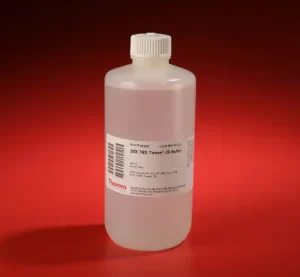
Thermo Scientific™ Pierce™ 20X TBS Tween™ 20 Buffer SKU: 28360
$139.15 Add to cart View Product DetailsOur variety of Pierce Concentrated Buffer stock solutions are ready to use without having to weigh and dissolve dry ingredients or adjust the pH with concentrated acid or base. Simply dilute the liquid stock solution with pure water and proceed with your experiment.
nBenefits of using Pierce Concentrated Buffer stock solutions include:
• Convenient—no weighing, no pH adjustment, no need to stock individual components
• Improved accuracy—ready-to-use formula, easily diluted without weighing chemical components
• Consistent quality—our quality control ensures that every prep will yield the same, consistent buffer
20X PBS Tween-20 can be used to prepare PBS-Tween (PBS-T) wash buffers for ELISA, western, and other immunoassays, as well as blocking buffer for plate-based assays. When diluted to 1X with water, 20X PBS Tween-20 makes 10 mM sodium phosphate, 0.15 M NaCl, 0.05% Tween™ 20 buffer at pH 7.5.
20X TBS Tween-20 (Tris-buffered saline with Tween™ 20 detergent) can be used to prepare TBS-Tween (TBS-T) wash buffers or blocking buffer diluent for applications such as ELISA, western blotting, and other immunoassays. When diluted 20-fold in water, a TBS Tween-20 buffer containing 25 mM Tris, 0.15 M NaCl, 0.05% Tween-20 at pH 7.5 is ready for use.
20X Tris-Buffered Saline (TBS) is a stock solution for preparing Tris-NaCl buffer for use as a wash buffer and antibody diluent for ELISA, western blotting, and other immunoassays. 20X Tris Buffered Saline (TBS) makes 25 mM Tris, 0.15 M NaCl with pH 7.2 to 7.5 when diluted to 1X with water.
20X Phosphate-Buffered Saline (PBS) is ideal for preparing PBS buffers for use in crosslinking, biotinylation, and fluorescent labeling reactions requiring an amine-free buffer. When diluted 20-fold in water, the solution yields 10 mM sodium phosphate, 0.15 M NaCl at pH 7.5.
10X Tris-Glycine-SDS Buffer makes 0.025 M Tris, 0.192M glycine, 0.1% sodium dodecyl sulfate (SDS) at pH 8.5 when diluted to 1X with water.
20X Borate Buffer is ideal for preparing sodium borate buffer solutions for use in protein modification procedures requiring amine-free buffer at an alkaline pH. 20X Borate Buffer makes 50 mM borate at pH 8.5 when diluted to 1X with water.
20X Modified Dulbecco’s PBS is used for preparing physiological Na- and K-phosphate buffered saline (D-PBS) used for wash buffers and antibody diluents in immunoassays like ELISA and western blot. 20X Modified Dulbecco’s PBS makes 8 mM sodium phosphate, 2 mM potassium phosphate, 0.14 M NaCl, 10 mM KCl, pH 7.4 when diluted to 1X with water.
10X Tris-Glycine Buffer is a space-saving stock solution that is ideal for quickly preparing standard Tris-glycine (pH 8.5) transfer buffer used for western blotting using Tris-glycine gel electrophoresis. When diluted 10-fold in water or 20% methanol, the solution yields 0.025 M Tris, 0.192 M glycine at pH 8.5.
10X TBE Buffer stock solution is ideal for casting and preparing Tris-borate-EDTA (TBE) running buffer used for agarose and polyacrylamide gel electrophoresis of nucleic acids. When diluted to 1X, the TBE Buffer contains 0.089 M Tris, 0.089 M borate, 2 mM EDTA with pH 8.2 to 8.4.
20X Modified Dulbecco’s PBS Tween-20 will make physiological sodium- and potassium-phosphate buffered saline (D-PBS) to be used as a wash buffer for ELISA, western, and other immunoassays or as diluent or blocking buffer for plate-based assays. 20X Modified Dulbecco’s PBS Tween-20 (D-PBS-T) makes 8 mM sodium phosphate, 2 mM potassium phosphate, 0.14 M NaCl, 10 mM KCl, 0.05% Tween™ 20 at pH 7.4 when diluted to 1X with water.
20X TAE Buffer is a space-saving stock solution that is ideal for casting and preparing Tris-acetate EDTA (TAE) running buffer for agarose gel electrophoresis of nucleic acids. When diluted to 1X with water, a 0.04 M Tris, 0.04 M acetate, 1 mM EDTA buffer at pH 8.2 to 8.4 is ready for use. -
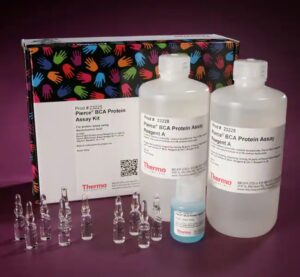
Thermo Scientific™ Pierce™ BCA Protein Assay Kit
$292.10 Add to cart View Product DetailsThermo Scientific™ Pierce BCA Protein Assay Kit remains one of the most popular protein quantitation methods worldwide.
nn
Used in more labs than any other detergent-compatible protein assay, Pierce BCA Reagents provide accurate determination of protein concentration with most sample types encountered in protein research. The Pierce BCA Assay can be used to assess yields in whole cell lysates and affinity-column fractions, as well as to monitor protein contamination in industrial applications. Compared to most dye-binding methods, the BCA Assay is affected much less by protein compositional differences, providing greater protein-to-protein uniformity.Highlights:n
-
- Colorimetric – estimate visually or measure with a standard spectrophotometer or plate reader (562nm)
n
-
- Excellent uniformity – exhibits less protein-to-protein variation than dye-binding methods
n
-
- Compatible – unaffected by typical concentrations of most ionic and nonionic detergents
n
-
- Moderately fast – much easier and four times faster than the classical Lowry method
n
-
- High linearity – linear working range for BSA equals 20 to 2000µg/mL
n
-
- Sensitive – detect down to 5µg/mL with the enhanced protocol
BCA Protein Assay Applications:n
-
- Studying protein:protein interactions
n
-
- Measuring column fractions after affinity chromatography
n
-
- Estimating percent recovery of membrane proteins from cell extracts
n
-
- High-throughput screening of fusion proteins
-
-
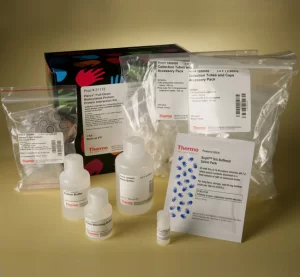
Thermo Scientific™ Pierce™ Biotinylated Protein Interaction Pull-Down Kit
$742.90 Add to cart View Product DetailsThermo Scientific™ Pierce Biotinylated Protein Interaction Pull-Down Kit contains the necessary components to capture and purify interactors of a biotin-labeled protein or ligand.
The kit makes it possible to perform an efficient pull-down assay with high protein recovery and reproducibility. This protocol uses immobilized streptavidin to capture a biotinylated protein and a spin column format that enables complete gel retention during each capture, wash and elution step. When the biotinylated bait protein is immobilized, it can withstand stringent washes and remains bound during prey protein elution, which results in an isolated prey protein without bait protein contamination. This technique is ideal when using native or recombinant proteins that are not expressed with a fusion tag. Additionally, prey protein is isolated from the immobilized bait protein using native binding conditions and nondenaturing elution conditions. The Biotinylated Protein Interaction Pull-Down Kit is designed to teach the method to first-time users and to increase ease-of-use and convenience for experienced researchers.
Highlights:
- Biotin pull-down – purifies protein interactors of any biotinylated protein or biotin-tagged ligand
- Complete kit – provides all components and detailed protocol for purifying protein:protein interactions
- No special equipment needed – uses common laboratory equipment and reagents (e.g., microcentrifuge)
- Spin column efficiency – microcentrifuge spin columns facilitate microcentrifuge spin columns facilitate simple and efficient manipulation of streptavidin agarose beads, including simple processing of multiple samples
Includes:
Streptavidin agarose resin, TBS pack, biotin blocking buffer, wash buffer, elution buffer, spin columns and collection tubes
Recommended for:
Discover a new protein interaction complex using a biotinylated protein as the bait to capture a putative binding partner from a cell lysate or other sample; Confirm expression of a known protein interaction target in a cell lysate; Determine the ability of two purified proteins to interact (bind) in various buffer conditions; Extract protein:protein interaction information from in vitro transcription/ translation lysates
-
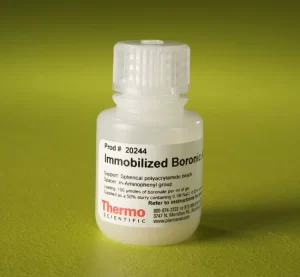
Thermo Scientific™ Pierce™ Boronic Acid Resin
$363.40 Add to cart View Product DetailsPerform ribonucleotide and oligonucleotide RNA isolation with Thermo Scientific™ Pierce Boronic Acid Resin.
This immobilized boronic acid is an easy-to-use polyacrylamide affinity support for purification of ribonucleotides and other small molecular weight compounds that contain cis-diol groups. The ligand (m-aminophenyl-boronic acid) binds to the cis-diol groups on the sugar portion of nucleotides, forming a reversible five-member ring complex. After washing away non-bound molecules from the sample, the complex can be dissociated and the nucleotide eluted by lowering the pH or by addition of sorbitol.
Highlights:
- Ligand – boronic acid
- Support – beaded polyacrylamide (1800 MW exclusion limit)
- Spacer – m-aminophenyl group
- Loading – 100μmol boronate per milliliter of settled resin
- Capacity – at least 99% binding and recovery of 110μmol AMP per milliliter of settled resin
- Format – 50% resin slurry in 0.05% sodium azide
-
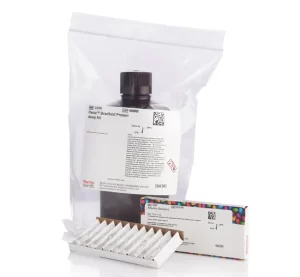
Thermo Scientific™ Pierce™ Bradford Protein Assay Kit
$178.25 Add to cart View Product DetailsMeasure protein concentration using a stable formulation of the original Bradford reagent described in the literature with Thermo Scientific™ Pierce Coomassie Protein Assay Kit.
The Pierce Coomassie Protein Assay Kit is a ready-to-use formulation of the popular assay reagent originally described by Bradford in 1976. When mixed with a protein solution, the acidic Coomassie-dye reagent changes color from brown to blue in proportion to the amount of protein present in the sample. Protein determinations are made by comparison to the color response of protein assay standards, usually prepared as a series of known dilutions of bovine serum albumin (BSA) or bovine gamma globulin (BGG). The kit includes Coomassie Protein Assay Reagent and a package of Albumin Standard Ampules. The simple procedure is adaptable to nearly any volume scale, including test tubes, cuvets and microplates.
Highlights:
- Bradford reagent – stable, ready-to-use kit of the classical Bradford assay reagent
- Colorimetric – measure with a standard spectrophotometer or plate reader (595nm)
- Easy to use – single reagent; no working reagent preparation required
- Fast – almost immediate color development; add, mix and read results
- Broad range – detects protein concentration in the range 1 to 1500μg/mL
- Flexible – microplate and cuvet protocols provided with the instructions and adaptable to several target working ranges
Includes:
Coomassie Protein Assay Reagent and 10 ampules of Albumin Standard
-
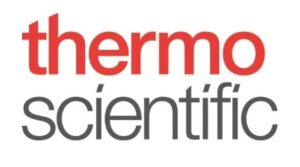
Thermo Scientific™ Pierce™ C18 Spin Tips & Columns
$425.50 Add to cart View Product DetailsMatrix-assisted laser desorption ionization (MALDI) and electrospray ionization (ESI) mass spectrometry (MS) provide high sensitivity and mass accuracy; however, interfering molecules from the sample can result in reduced sensitivity and poor-quality spectra. Sample clean-up with C18 resins significantly improves signal-to-noise ratios and sequence coverage by removing MS-incompatible salts and detergents commonly used in protein or peptide preparation. The optimized protocol for the Pierce C-18 Spin Columns effectively removes contaminants and elutes peptides in MS-compatible solutions.
Pierce C18 Spin Columns
Thermo Scientific Pierce C18 Spin Columns are ready-to-use centrifuge columns of porous C18 reverse-phase resin for peptide sample preparation for MS and other analysis methods. The protocol has been optimized to efficiently remove interfering contaminants and release peptides in MS-compatible solutions. Columns can be used effectively for processing peptides derived from 10 ng to 30 μg of protein. Sensitivity and detection limits are dependent on the downstream application.• Efficient—effectively removes interfering contaminants to improve spectral quality and is suitable for a variety of reverse-phase-compatible contaminants
• Flexible—works with a wide variety of load volumes and concentrations; no need to reduce sample volume before application
• Convenient—spin column format requires no special equipment to process multiple samples simultaneously
• Robust—special C18 resin allows excellent recovery percentages, even at low (sub-picomole) sample loadsPierce C18 Spin Tips
Thermo Scientific Pierce C18 Spin Tips enable fast and efficient capture, concentration, desalting, and elution of up to 10 μg of peptides per 20 μL of sample with volumes ranging from 10 to 100 μL. The five-step procedure is simple and requires less than five minutes to process protein digests, strong cation exchange fractions, and other protein and peptide samples for mass spectrometric (MS) analyses. The Pierce C18 Spin Tips offer excellent flow properties with a high-efficiency monolithic C18 sorbent for fast wetting, loading, washing, and eluting.• Efficient—effectively removes interfering contaminants to improve spectral quality and is suitable for a variety of reverse-phase-compatible contaminants
• Rapid—C18 fast-flow tips have low resistance and improved flow
• Convenient—spin tips are provided with tip adaptor for easy centrifugation
• Cleaner sample—device filters particulates that can cause autosampler and column cloggingApplications
• Clean-up of peptides after protein digestion
• Peptide sample concentration and desalting
• Sample preparation for MALDI peptide analysis and proteomics workflowsMatrix-assisted laser desorption ionization (MALDI) and electrospray ionization (ESI) mass spectrometry (MS) are essential for studying biological compounds because of the high sensitivity and mass accuracy they provide. However, many of the buffers and compounds common to biological samples interfere with both MALDI-MS and ESI-MS, resulting in reduced sensitivity and poor-quality spectra. Pierce C-18 Spin Columns remove interfering contaminants and release peptides in MS-compatible solutions, providing an effective tool that aids in the MS examination of post-translational modifications or for the identification of proteins by peptide mapping.
-
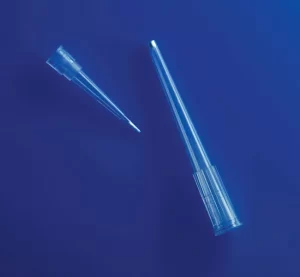
Thermo Scientific™ Pierce™ C18 Spin Tips & Columns
$374.90 Add to cart View Product DetailsMatrix-assisted laser desorption ionization (MALDI) and electrospray ionization (ESI) mass spectrometry (MS) provide high sensitivity and mass accuracy; however, interfering molecules from the sample can result in reduced sensitivity and poor-quality spectra. Sample clean-up with C18 resins significantly improves signal-to-noise ratios and sequence coverage by removing MS-incompatible salts and detergents commonly used in protein or peptide preparation. The optimized protocol for the Pierce C-18 Spin Columns effectively removes contaminants and elutes peptides in MS-compatible solutions.
Pierce C18 Spin Columns
Thermo Scientific Pierce C18 Spin Columns are ready-to-use centrifuge columns of porous C18 reverse-phase resin for peptide sample preparation for MS and other analysis methods. The protocol has been optimized to efficiently remove interfering contaminants and release peptides in MS-compatible solutions. Columns can be used effectively for processing peptides derived from 10 ng to 30 μg of protein. Sensitivity and detection limits are dependent on the downstream application.• Efficient—effectively removes interfering contaminants to improve spectral quality and is suitable for a variety of reverse-phase-compatible contaminants
• Flexible—works with a wide variety of load volumes and concentrations; no need to reduce sample volume before application
• Convenient—spin column format requires no special equipment to process multiple samples simultaneously
• Robust—special C18 resin allows excellent recovery percentages, even at low (sub-picomole) sample loadsPierce C18 Spin Tips
Thermo Scientific Pierce C18 Spin Tips enable fast and efficient capture, concentration, desalting, and elution of up to 10 μg of peptides per 20 μL of sample with volumes ranging from 10 to 100 μL. The five-step procedure is simple and requires less than five minutes to process protein digests, strong cation exchange fractions, and other protein and peptide samples for mass spectrometric (MS) analyses. The Pierce C18 Spin Tips offer excellent flow properties with a high-efficiency monolithic C18 sorbent for fast wetting, loading, washing, and eluting.• Efficient—effectively removes interfering contaminants to improve spectral quality and is suitable for a variety of reverse-phase-compatible contaminants
• Rapid—C18 fast-flow tips have low resistance and improved flow
• Convenient—spin tips are provided with tip adaptor for easy centrifugation
• Cleaner sample—device filters particulates that can cause autosampler and column cloggingApplications
• Clean-up of peptides after protein digestion
• Peptide sample concentration and desalting
• Sample preparation for MALDI peptide analysis and proteomics workflowsMatrix-assisted laser desorption ionization (MALDI) and electrospray ionization (ESI) mass spectrometry (MS) are essential for studying biological compounds because of the high sensitivity and mass accuracy they provide. However, many of the buffers and compounds common to biological samples interfere with both MALDI-MS and ESI-MS, resulting in reduced sensitivity and poor-quality spectra. Pierce C-18 Spin Columns remove interfering contaminants and release peptides in MS-compatible solutions, providing an effective tool that aids in the MS examination of post-translational modifications or for the identification of proteins by peptide mapping.
-
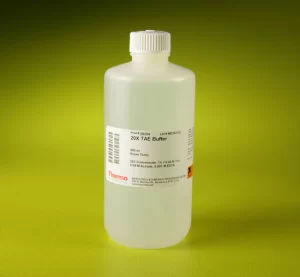
Thermo Scientific™ Pierce™ Concentrated Buffer Stocks (10X and 20X) X
$138.00 Add to cart View Product DetailsOur variety of Pierce Concentrated Buffer stock solutions are ready to use without having to weigh and dissolve dry ingredients or adjust the pH with concentrated acid or base. Simply dilute the liquid stock solution with pure water and proceed with your experiment.
Benefits of using Pierce Concentrated Buffer stock solutions include:
• Convenient—no weighing, no pH adjustment, no need to stock individual components
• Improved accuracy—ready-to-use formula, easily diluted without weighing chemical components
• Consistent quality—our quality control ensures that every prep will yield the same, consistent buffer20X PBS Tween-20 can be used to prepare PBS-Tween (PBS-T) wash buffers for ELISA, western, and other immunoassays, as well as blocking buffer for plate-based assays. When diluted to 1X with water, 20X PBS Tween-20 makes 10 mM sodium phosphate, 0.15 M NaCl, 0.05% Tween™ 20 buffer at pH 7.5.
20X TBS Tween-20 (Tris-buffered saline with Tween™ 20 detergent) can be used to prepare TBS-Tween (TBS-T) wash buffers or blocking buffer diluent for applications such as ELISA, western blotting, and other immunoassays. When diluted 20-fold in water, a TBS Tween-20 buffer containing 25 mM Tris, 0.15 M NaCl, 0.05% Tween-20 at pH 7.5 is ready for use.
20X Tris-Buffered Saline (TBS) is a stock solution for preparing Tris-NaCl buffer for use as a wash buffer and antibody diluent for ELISA, western blotting, and other immunoassays. 20X Tris Buffered Saline (TBS) makes 25 mM Tris, 0.15 M NaCl with pH 7.2 to 7.5 when diluted to 1X with water.
20X Phosphate-Buffered Saline (PBS) is ideal for preparing PBS buffers for use in crosslinking, biotinylation, and fluorescent labeling reactions requiring an amine-free buffer. When diluted 20-fold in water, the solution yields 10 mM sodium phosphate, 0.15 M NaCl at pH 7.5.
10X Tris-Glycine-SDS Buffer makes 0.025 M Tris, 0.192M glycine, 0.1% sodium dodecyl sulfate (SDS) at pH 8.5 when diluted to 1X with water.
20X Borate Buffer is ideal for preparing sodium borate buffer solutions for use in protein modification procedures requiring amine-free buffer at an alkaline pH. 20X Borate Buffer makes 50 mM borate at pH 8.8 when diluted to 1X with water.
20X Modified Dulbecco’s PBS is used for preparing physiological Na- and K-phosphate buffered saline (D-PBS) used for wash buffers and antibody diluents in immunoassays like ELISA and western blot. 20X Modified Dulbecco’s PBS makes 8 mM sodium phosphate, 2 mM potassium phosphate, 0.14 M NaCl, 10 mM KCl, pH 7.4 when diluted to 1X with water.
10X Tris-Glycine Buffer is a space-saving stock solution that is ideal for quickly preparing standard Tris-glycine (pH 8.5) transfer buffer used for western blotting using Tris-glycine gel electrophoresis. When diluted 10-fold in water or 20% methanol, the solution yields 0.025 M Tris, 0.192 M glycine at pH 8.5.
10X TBE Buffer stock solution is ideal for casting and preparing Tris-borate-EDTA (TBE) running buffer used for agarose and polyacrylamide gel electrophoresis of nucleic acids. When diluted to 1X, the TBE Buffer contains 0.089 M Tris, 0.089 M borate, 2 mM EDTA with pH 8.2 to 8.4.
20X Modified Dulbecco’s PBS Tween-20 will make physiological sodium- and potassium-phosphate buffered saline (D-PBS) to be used as a wash buffer for ELISA, western, and other immunoassays or as diluent or blocking buffer for plate-based assays. 20X Modified Dulbecco’s PBS Tween-20 (D-PBS-T) makes 8 mM sodium phosphate, 2 mM potassium phosphate, 0.14 M NaCl, 10 mM KCl, 0.05% Tween™ 20 at pH 7.4 when diluted to 1X with water.
20X TAE Buffer is a space-saving stock solution that is ideal for casting and preparing Tris-acetate EDTA (TAE) running buffer for agarose gel electrophoresis of nucleic acids. When diluted to 1X with water, a 0.04 M Tris, 0.04 M acetate, 1 mM EDTA buffer at pH 8.2 to 8.4 is ready for use.
-
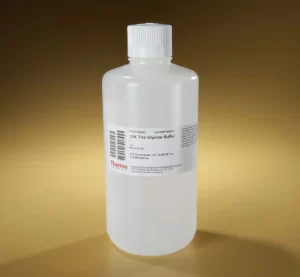
Thermo Scientific™ Pierce™ Concentrated Buffer Stocks (10X and 20X) X
$106.09 Add to cart View Product DetailsOur variety of Pierce Concentrated Buffer stock solutions are ready to use without having to weigh and dissolve dry ingredients or adjust the pH with concentrated acid or base. Simply dilute the liquid stock solution with pure water and proceed with your experiment.
Benefits of using Pierce Concentrated Buffer stock solutions include:
• Convenient—no weighing, no pH adjustment, no need to stock individual components
• Improved accuracy—ready-to-use formula, easily diluted without weighing chemical components
• Consistent quality—our quality control ensures that every prep will yield the same, consistent buffer20X PBS Tween-20 can be used to prepare PBS-Tween (PBS-T) wash buffers for ELISA, western, and other immunoassays, as well as blocking buffer for plate-based assays. When diluted to 1X with water, 20X PBS Tween-20 makes 10 mM sodium phosphate, 0.15 M NaCl, 0.05% Tween™ 20 buffer at pH 7.5.
20X TBS Tween-20 (Tris-buffered saline with Tween™ 20 detergent) can be used to prepare TBS-Tween (TBS-T) wash buffers or blocking buffer diluent for applications such as ELISA, western blotting, and other immunoassays. When diluted 20-fold in water, a TBS Tween-20 buffer containing 25 mM Tris, 0.15 M NaCl, 0.05% Tween-20 at pH 7.5 is ready for use.
20X Tris-Buffered Saline (TBS) is a stock solution for preparing Tris-NaCl buffer for use as a wash buffer and antibody diluent for ELISA, western blotting, and other immunoassays. 20X Tris Buffered Saline (TBS) makes 25 mM Tris, 0.15 M NaCl with pH 7.2 to 7.5 when diluted to 1X with water.
20X Phosphate-Buffered Saline (PBS) is ideal for preparing PBS buffers for use in crosslinking, biotinylation, and fluorescent labeling reactions requiring an amine-free buffer. When diluted 20-fold in water, the solution yields 10 mM sodium phosphate, 0.15 M NaCl at pH 7.5.
10X Tris-Glycine-SDS Buffer makes 0.025 M Tris, 0.192M glycine, 0.1% sodium dodecyl sulfate (SDS) at pH 8.5 when diluted to 1X with water.
20X Borate Buffer is ideal for preparing sodium borate buffer solutions for use in protein modification procedures requiring amine-free buffer at an alkaline pH. 20X Borate Buffer makes 50 mM borate at pH 8.8 when diluted to 1X with water.
20X Modified Dulbecco’s PBS is used for preparing physiological Na- and K-phosphate buffered saline (D-PBS) used for wash buffers and antibody diluents in immunoassays like ELISA and western blot. 20X Modified Dulbecco’s PBS makes 8 mM sodium phosphate, 2 mM potassium phosphate, 0.14 M NaCl, 10 mM KCl, pH 7.4 when diluted to 1X with water.
10X Tris-Glycine Buffer is a space-saving stock solution that is ideal for quickly preparing standard Tris-glycine (pH 8.5) transfer buffer used for western blotting using Tris-glycine gel electrophoresis. When diluted 10-fold in water or 20% methanol, the solution yields 0.025 M Tris, 0.192 M glycine at pH 8.5.
10X TBE Buffer stock solution is ideal for casting and preparing Tris-borate-EDTA (TBE) running buffer used for agarose and polyacrylamide gel electrophoresis of nucleic acids. When diluted to 1X, the TBE Buffer contains 0.089 M Tris, 0.089 M borate, 2 mM EDTA with pH 8.2 to 8.4.
20X Modified Dulbecco’s PBS Tween-20 will make physiological sodium- and potassium-phosphate buffered saline (D-PBS) to be used as a wash buffer for ELISA, western, and other immunoassays or as diluent or blocking buffer for plate-based assays. 20X Modified Dulbecco’s PBS Tween-20 (D-PBS-T) makes 8 mM sodium phosphate, 2 mM potassium phosphate, 0.14 M NaCl, 10 mM KCl, 0.05% Tween™ 20 at pH 7.4 when diluted to 1X with water.
20X TAE Buffer is a space-saving stock solution that is ideal for casting and preparing Tris-acetate EDTA (TAE) running buffer for agarose gel electrophoresis of nucleic acids. When diluted to 1X with water, a 0.04 M Tris, 0.04 M acetate, 1 mM EDTA buffer at pH 8.2 to 8.4 is ready for use.
-
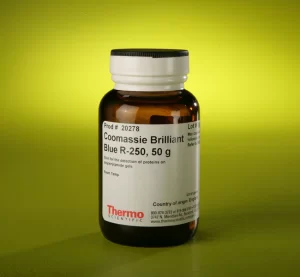
Thermo Scientific™ Pierce™ Coomassie Brilliant Blue Dyes
$223.31 Add to cart View Product DetailsThermo Scientific Pierce Coomassie Brilliant Blue dyes are composed of one of the most common forms of coomassie dye, which is a key component of various colorimetric protein gel stains. Coomassie R-250 and G-250 dyes are two chemical forms of a disulfonated triphenylmethane compound that is commonly used as the basis of stains for detection of proteins in gel electrophoresis and Bradford-type assay reagents for protein quantitation. The R-250 (red-tinted) form lacks two methyl groups that are present in the G-250 (green-tinted) form, which is also called colloidal coomassie dye.
Coomassie R-250 and G-250 dyes are two chemical forms of a disulfonated triphenylmethane compound that is commonly used as the basis of stains for detection of proteins in gel electrophoresis and Bradford-type assay reagents for protein quantitation. The R-250 (red-tinted) form lacks two methyl groups that are present in the G-250 (green-tinted) form, which is also called colloidal coomassie dye.
Typically, coomassie gel stains and protein assay reagents are formulated as very acidic solutions in 25 to 50% methanol. In acidic conditions, the dye binds to proteins primarily through basic amino acids (primarily arginine, lysine, and histidine), and the number of coomassie dye ligands bound to each protein molecule is approximately proportional to the number of positive charges found on the protein. Protein binding causes the dye to change from reddish-brown to bright blue (absorption maximum equals 595 nm).
Features include:
• Easy detection—develops intensely colored complexes with proteins
• High sensitivity—can determine as little as 0.5 μg/cm2 of protein present in a gel matrix
• Reversible staining—anion of Coomassie Brilliant Blue dye formed in the acidic staining medium combines with the protonated amino groups of proteins by electrostatic interaction; resulting complex is reversible under proper conditions
• Differentiation between bound and unbound dye—when dissolved in 0.01 M citrate buffer at pH 3.0, has an absorption maximum at 555 nm; protein-dye complex is characterized by a peak slightly broader than that of free dye with a maximum at 549 nm -
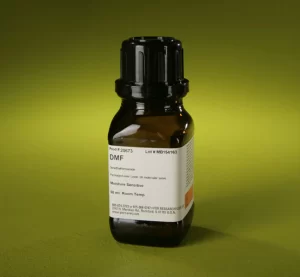
Thermo Scientific™ Pierce™ Dimethylformamide (DMF), Sequencing grade
$89.13 Add to cart View Product DetailsThermo Scientific Pierce Dimethylformamide (DMF) is a sequencing-grade preparation with high purity and consistent absorptivity properties for use in HPLC and mass spectrometry methods.
This sequencing-grade dimethylformamide is specially purified by a proprietary method and tested to ensure lot-to-lot consistency with a low UV absorbance to provide you with the most sensitive detection across all wavelengths. DMF is packaged in solvent-rinsed amber glass bottles and sealed with PTFE-lined fluorocarbon caps for ultimate protection.
Highlights:
- Highly purified and tested to ensure reliable performance in HPLC, mass spectrometry and sequencing applications
- Packaged in solvent-rinsed amber glass bottles and sealed with PTFE-lined fluorocarbon caps
Product Details:
- General properties of DMF
- Alternative names: n,n-Dimethylformamide, n-Formyldimethylamine
- Molecular formula: C3H7ON
- Molecular weight: 73.09
- Density:0.945g/mL
- CAS number: 68-12-2
Pierce sequencing-grade DMF is specially purified and tested to the highest specifications to ensure the integrity of your data, maximize sensitivity in your assay and prolong the life of your equipment.
-
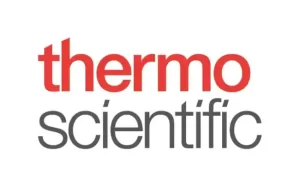
Thermo Scientific™ Pierce™ Disposable Column Trial Pack
$131.10 Add to cart View Product DetailsThermo Scientific™ Pierce Disposable Plastic Columns are empty columns with matching frits and caps for use in a variety of resin-based affinity or desalting techniques.
These bulk packages of empty columns are economical and convenient devices for packing affinity purification supports and desalting resins for gravity-flow procedures. Three columns sizes are offered, suitable for procedures requiring 0.5 to 10mL resin-bed volumes. The plastic columns are supplied with matching pairs of polyethylene discs and polypropylene caps (top and bottom). The columns are economically-priced for single use and sufficiently durable to prepare and store columns for multiple uses.
Highlights:
- For bench top gravity-flow affinity purification and size exclusion chromatography
- Supplied complete with porous polyethylene discs, stoppers and end caps
- Columns can be pre-packed and stored until needed
- Compatible with most types of aqueous buffer eluents commonly used in chromatography
- Plastic funnels can be attached to expand the buffer reservoir for increased flow rates
Includes:
Trial pack contains two columns of each available size (six columns total), matching column accessories (discs and caps), and one funnel (column reservoir extender)
-

Thermo Scientific™ Pierce™ Disposable Columns, 10 mL
$378.35 Add to cart View Product DetailsThermo Scientific™ Pierce Disposable Plastic Columns are empty columns with matching frits and caps for use in a variety of resin-based affinity or desalting techniques.
These bulk packages of empty columns are economical and convenient devices for packing affinity purification supports and desalting resins for gravity-flow procedures. Three columns sizes are offered, suitable for procedures requiring 0.5 to 10mL resin-bed volumes. The plastic columns are supplied with matching pairs of polyethylene discs and polypropylene caps (top and bottom). The columns are economically-priced for single use and sufficiently durable to prepare and store columns for multiple uses.
Highlights:
- For bench top gravity-flow affinity purification and size exclusion chromatography
- Supplied complete with porous polyethylene discs, stoppers and end caps
- Columns can be pre-packed and stored until needed
- Compatible with most types of aqueous buffer eluents commonly used in chromatography
- Plastic funnels can be attached to expand the buffer reservoir for increased flow rates
Includes:
Trial pack contains two columns of each available size (six columns total), matching column accessories (discs and caps), and one funnel (column reservoir extender)
-
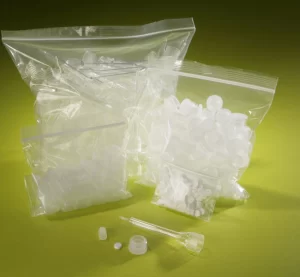
Thermo Scientific™ Pierce™ Disposable Columns, 2 mL
$297.85 Add to cart View Product DetailsThermo Scientific™ Pierce Disposable Plastic Columns are empty columns with matching frits and caps for use in a variety of resin-based affinity or desalting techniques.
Additional Information and Online Ordering
These bulk packages of empty columns are economical and convenient devices for packing affinity purification supports and desalting resins for gravity-flow procedures. Three columns sizes are offered, suitable for procedures requiring 0.5 to 10mL resin-bed volumes. The plastic columns are supplied with matching pairs of polyethylene discs and polypropylene caps (top and bottom). The columns are economically-priced for single use and sufficiently durable to prepare and store columns for multiple uses.
Highlights:
- For bench top gravity-flow affinity purification and size exclusion chromatography
- Supplied complete with porous polyethylene discs, stoppers and end caps
- Columns can be pre-packed and stored until needed
- Compatible with most types of aqueous buffer eluents commonly used in chromatography
- Plastic funnels can be attached to expand the buffer reservoir for increased flow rates
Includes:
Trial pack contains two columns of each available size (six columns total), matching column accessories (discs and caps), and one funnel (column reservoir extender)
-

Thermo Scientific™ Pierce™ Disposable Columns, 5 mL
$369.15 Add to cart View Product DetailsThermo Scientific™ Pierce Disposable Plastic Columns are empty columns with matching frits and caps for use in a variety of resin-based affinity or desalting techniques.
Additional Information and Online Ordering
These bulk packages of empty columns are economical and convenient devices for packing affinity purification supports and desalting resins for gravity-flow procedures. Three columns sizes are offered, suitable for procedures requiring 0.5 to 10mL resin-bed volumes. The plastic columns are supplied with matching pairs of polyethylene discs and polypropylene caps (top and bottom). The columns are economically-priced for single use and sufficiently durable to prepare and store columns for multiple uses.
Highlights:
- For bench top gravity-flow affinity purification and size exclusion chromatography
- Supplied complete with porous polyethylene discs, stoppers and end caps
- Columns can be pre-packed and stored until needed
- Compatible with most types of aqueous buffer eluents commonly used in chromatography
- Plastic funnels can be attached to expand the buffer reservoir for increased flow rates
Includes:
Trial pack contains two columns of each available size (six columns total), matching column accessories (discs and caps), and one funnel (column reservoir extender)
-
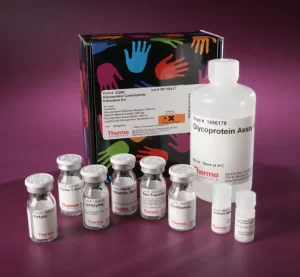
Thermo Scientific™ Pierce™ Glycoprotein Carbohydrate Estimation Kit
$607.20 Add to cart View Product DetailsThermo Scientific™ Pierce Glycoprotein Carbohydrate Estimation Kit enables the amount of protein glycosylation to be measured as the percent of total purified protein mass.
The Glycoprotein Carbohydrate Estimation Kit includes six purified glycoprotein standards and the required assay reagents to effectively estimate the amount of oxidizable glycosylation (% carbohydrate by weight) of purified protein samples. Sugar groups in the glycoprotein sample are first oxidized with sodium meta-periodate to produce detectable aldehyde groups. Then the sample is reacted with the colorimetric Glycoprotein Detection Reagent. Absorbance at 550nm of the resulting purple reaction product is measured with a spectrophotometer or plate reader. Finally, the carbohydrate content in the glycoprotein is calculated by comparison to results from the five glycoprotein standards that are included in the kit.
Highlights:
- Qualitative – easily identifies purified proteins as glycoproteins or samples as contaminated with sugars
- Semi-quantitative – estimates the percent carbohydrate content (w/w) of purified glycoprotein by comparison to the included set of glycoprotein standards
- Simple procedure – completed in less than 75 minutes; instructions include microplate and test tube protocols
- Adaptable – standard curve format allows for the design of alternative tests for aldehydes and carbohydrate components
Includes:
Sodium periodate, assay buffer, detection reagent and a 5-vial set of glycoprotein standards
Recommended for:
Determine if a purified polyclonal antibody or other protein is glycosylated before attempting to perform carbohydrate-based conjugation or immobilization chemistries with hydrazide reagents; Characterize and classify purified protein fractions from an affinity procedure; Assess sugar and carbohydrate contamination in non-glycosylated protein samples
-

Thermo Scientific™ Pierce™ Heptafluorobutyric Acid (HFBA), HPLC Grade
$198.96 Add to cart View Product DetailsThermo Scientific™ Pierce Heptafluorobutyric Acid (HFBA) is manufactured and tested to meet strict specifications that ensure superior performance for use as an ion-pairing agent in reverse-phase peptide separations.
Highlights:
- Typical purity is 99.7% by GC; <0.1% water
- Sequencing reagent for classical and automated Edman degradation of peptides and proteins
- Density: 1.645
- B.P. 120°C
- Packaged under nitrogen in amber glass ampules or bottles
- Clear, colorless liquid
Ordering Information:
X in the ordering table indicates that hazardous shipping charges apply.
-
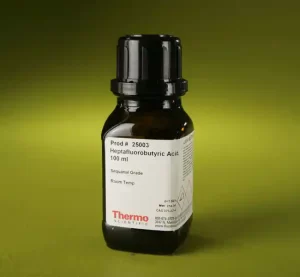
Thermo Scientific™ Pierce™ Heptafluorobutyric Acid (HFBA), Sequencing Grade
$699.20 Add to cart View Product DetailsThermo Scientific™ Pierce Heptafluorobutyric Acid (HFBA) is manufactured and tested to meet strict specifications that ensure superior performance for use as an ion-pairing agent in reverse-phase peptide separations.
Highlights:
- Typical purity is 99.7% by GC; <0.1% water
- Sequencing reagent for classical and automated Edman degradation of peptides and proteins
- Density: 1.645
- B.P. 120°C
- Packaged under nitrogen in amber glass ampules or bottles
- Clear, colorless liquid
Ordering Information:
X in the ordering table indicates that hazardous shipping charges apply
-
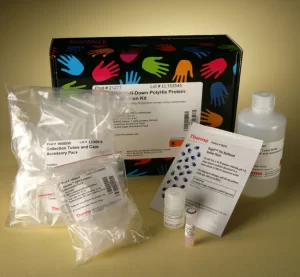
Thermo Scientific™ Pierce™ His Protein Interaction Pull-Down Kit
$632.50 Add to cart View Product DetailsThermo Scientific™ Pierce PolyHis Protein Interaction Pull-Down Kit purifies protein interaction complexes involving practically any user-supplied His-tagged fusion protein.
The PolyHis Protein Interaction Pull-Down Kit contains the necessary components to capture and purify proteins that interact with recombinant proteins containing a histidine (6xHis) fusion tag. You provide the tagged fusion protein (bait) and cells expressing the putative protein interaction target (prey), and the pull-down kit supplies everything else: cell lysis buffer, microcentrifuge spin columns, cobalt-IMAC affinity resin (agarose beads), optimized binding and elution buffers, and a detailed protocol. This kit is designed to teach the method to first-time users and to increase ease-of-use, convenience and reproducibility for experienced researchers.
Highlights:
- 6xHis pull-down – purifies protein interactors of any His-tagged fusion protein
- Complete kit – provides all components and detailed protocol for purifying protein:protein interactions
- No special equipment needed – uses common laboratory equipment and reagents (e.g., microcentrifuge)
- Convenient – microcentrifuge spin columns facilitate simple and efficient manipulation of cobalt IMAC agarose beads, including simple processing of multiple samples
- Flexible – instructions include protocols for bait and prey proteins from different sources
Includes:
Cobalt chelate agarose resin, lysis buffer, TBS pack, imidazole solution for elution, microcentrifuge spin columns and collection tubes
Recommended for:
Discover a new protein:protein interaction from a cell lysate; Confirm a putative interaction from a cell lysate or with a previously purified protein; Extract protein:protein interaction information from in vitro transcription/translation lysates
-
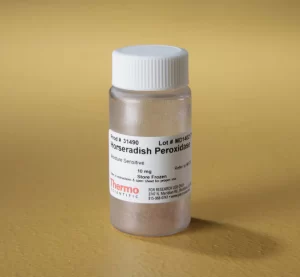
Thermo Scientific™ Pierce™ Horseradish Peroxidase X
$127.65 Add to cart View Product DetailsThermo Scientific™ Pierce Horseradish Peroxidase (HRP) is purified horseradish peroxidase enzyme for use in activity assays and conjugation to antibodies for ELISA, Western blotting and immunohistochemistry applications.
Highlights:
- Superior to alkaline phosphatase and β-galactosidase conjugates due to the higher specific enzyme activity
- Small size (40kDa) allows excellent cellular penetration
- Variety of substrates available
- Ideal in blotting and cytochemistry applications
- Used as the reporter enzyme for Thermo Scientific SuperSignal Chemiluminescent Western Blotting and ELISA Substrates
Note:
Porstmann, B., Porstmann, T., Nugel, E. and Evers, U. (1985). Which of the commonly used marker enzymes gives the best results in colorimetric and fluorimetric enzyme immunoassays: horseradish peroxidase, alkaline phosphatase, β-galactosidase, J. Immunol. Meth. 79, 27-37.
Wordinger, R.J., Miller, G.W. and Nicodemus, D.S. (1987). Manual of Immunoperoxidase Techniques, 2nd Edition. Chicago: American Society of Clinical Pathologists Press, pp. 23-24.
Yolken, R.H. (1982). Enzyme immunoassays for the detection of infectious antigens in body fluids: current limitations and future prospects. Rev. Infect. Dis. 4(1), 35-68.
Cordell, J.L., et al. (1984). Immunoenzymatic labeling of monoclonal antibodies using immune complexes of alkaline phosphatase and monoclonal anti-alkaline phosphatase (APAAP complexes). J. Histochem. Cytochem. 32, 219-229.
Passey, R.B., et al. (1977). Evaluation and comparison of 10 glucose methods and the reference method recommended in the proposed product class standard. Clin. Chem. 23(1), 131.
Hosoda, H., Takasaki, W., Tsukamoto, R. and Nambara, T. (1987). Sensitivity of steroid immunoassays. Comparison of alkaline phosphatase, β-galactosidase and horseradish peroxidase as labels in a colorimetric assay system. Chem. Pharm. Bull. 35, 3336-3342.
Samoszuk, M.K., et al. (1989). Antibody, Immunoconjugates and Radiopharmaceuticals 2, 37-46.
-

Thermo Scientific™ Pierce™ Horseradish Peroxidase X
$430.10 Add to cart View Product DetailsThermo Scientific™ Pierce Horseradish Peroxidase (HRP) is purified horseradish peroxidase enzyme for use in activity assays and conjugation to antibodies for ELISA, Western blotting and immunohistochemistry applications.
Highlights:
- Superior to alkaline phosphatase and β-galactosidase conjugates due to the higher specific enzyme activity
- Small size (40kDa) allows excellent cellular penetration
- Variety of substrates available
- Ideal in blotting and cytochemistry applications
- Used as the reporter enzyme for Thermo Scientific SuperSignal Chemiluminescent Western Blotting and ELISA Substrates
Note:
Porstmann, B., Porstmann, T., Nugel, E. and Evers, U. (1985). Which of the commonly used marker enzymes gives the best results in colorimetric and fluorimetric enzyme immunoassays: horseradish peroxidase, alkaline phosphatase, β-galactosidase, J. Immunol. Meth. 79, 27-37.
Wordinger, R.J., Miller, G.W. and Nicodemus, D.S. (1987). Manual of Immunoperoxidase Techniques, 2nd Edition. Chicago: American Society of Clinical Pathologists Press, pp. 23-24.
Yolken, R.H. (1982). Enzyme immunoassays for the detection of infectious antigens in body fluids: current limitations and future prospects. Rev. Infect. Dis. 4(1), 35-68.
Cordell, J.L., et al. (1984). Immunoenzymatic labeling of monoclonal antibodies using immune complexes of alkaline phosphatase and monoclonal anti-alkaline phosphatase (APAAP complexes). J. Histochem. Cytochem. 32, 219-229.
Passey, R.B., et al. (1977). Evaluation and comparison of 10 glucose methods and the reference method recommended in the proposed product class standard. Clin. Chem. 23(1), 131.
Hosoda, H., Takasaki, W., Tsukamoto, R. and Nambara, T. (1987). Sensitivity of steroid immunoassays. Comparison of alkaline phosphatase, β-galactosidase and horseradish peroxidase as labels in a colorimetric assay system. Chem. Pharm. Bull. 35, 3336-3342.
Samoszuk, M.K., et al. (1989). Antibody, Immunoconjugates and Radiopharmaceuticals 2, 37-46.
-
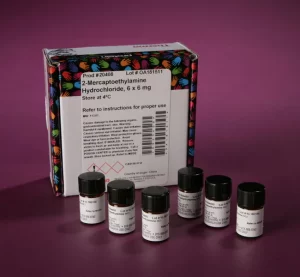
Thermo Scientific™ Pierce™ Mercaptoethylamine-HCl
$270.25 Add to cart View Product DetailsThermo Scientific™ Pierce 2-Mercaptoethylamine-HCl, commonly abbreviated 2-MEA, is a mild reductant that is often used to selectively reduce hinge-region disulfide bonds in antibody.
-
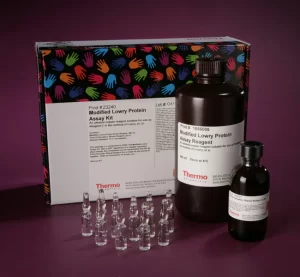
Thermo Scientific™ Pierce™ Modified Lowry Protein Assay Kit
$269.10 Add to cart View Product DetailsThermo Scientific™ Pierce Modified Lowry Protein Assay is a classical, well-characterized copper-based method for measuring protein concentration.
The Modified Lowry Protein Assay Kit combines a stabilized formulation of the original Lowry Reagents and the essential Folin-Ciocalteu Phenol reagent in a complete kit for accurately determining protein concentration in a variety of samples types. Although newer protein assay methods provide greater speed and convenience, the Lowry method remains a popular, accurate, and useful option for many applications.
Highlights:
- Popular method – widely cited in protein research literature
- Colorimetric – measure with a standard spectrophotometer or plate reader (750nm)
- Stable – uses a modified cupric sulfate-tartrate reagent that is stable at room temperature
- Large range – exhibits good linearity in the range 1 to 1500μg/mL (tested with BSA protein)
- Convenient – microplate and cuvet protocols provided with the instructions
Includes:
Modified Lowry Protein Assay Reagent, Folin-Ciocalteu Phenol Reagent (2N), and ampules of Albumin Standard (2mg/mL)
-
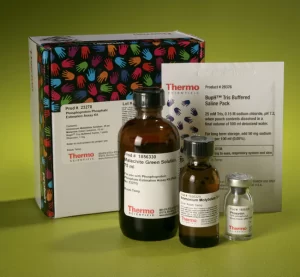
Thermo Scientific™ Pierce™ Phosphoprotein Phosphate Estimation Assay Kit
$713.00 Add to cart View Product DetailsThermo Scientific™ Phosphoprotein Phosphate Estimation Kit enables classification and identification of proteins as phosphorylated (serine and threonine), as well as semi-quantitative assessment of the phosphorylation level.
The Phosphoprotein Phosphate Estimation Assay Kit is designed to aid in characterization of the status and extent of phosphorylation of purified protein samples. The assay is based on the alkaline hydrolysis of phosphate from seryl and threonyl residues in phosphoproteins and quantification of the released phosphate with malachite green and ammonium molybdate. The assay is easily performed in 96-well microplates or test tubes and is completed in about one hour.
The assay can be used to identify whether a purified protein contains either phospho-serine (p-Ser) or phospho-threonine (p-Thr) as well as to estimate the level of this type of phosphorylation. For quantitation, the test protein sample is compared with specific concentrations of phosvitin, a phosphoprotein of known phosphorylation level. The alkaline hydrolysis step does not release phosphate from phospho-tyrosine (p-Tyr) residues in peptide linkage. Therefore, a negative result for an unknown purified protein preparation indicates that the protein is either (1) not a phosphoprotein or (2) is phosphorylated exclusively at tyrosine residues. In the latter case, Western blot analysis using an anti-phosphotyrosine antibody will be necessary to distinguish between these two possibilities.
Highlights:
- Specific – measures phosphoserine (p-Ser) and phosphothreonine (p-Thr) only; does not measure phosphotyrosine (p-Tyr)
- Convenient – test tube and 96-well microplate protocols included and require less than 90 minutes to perform
- Semi-quantitative – calculate moles of phosphate (P) per mole of protein using the included phosvitin standard
- Customizable – format is adaptable to development of specific assays for pure phosphoproteins when previously characterized standards are available
Includes:
Ammonium molybdate solution, malachite green solution, Tris-buffered saline pack and phopvitin positive control
Recommended for:
Identify proteins as containing phosphoserine or phosphothreonine phosphorylations; Estimate the amount of pS and pT phosphorylation; Develop specific quantitative assays for well-characterized phosphoproteins of interest
-
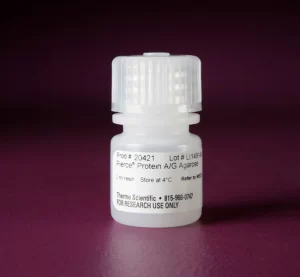
Thermo Scientific™ Pierce™ Protein A/G Agarose X
$657.80 Add to cart View Product DetailsThermo Scientific™ Pierce Protein A/G Agarose is a versatile, high-performance affinity resin for antibody purification that is available as bottled agarose beads, pre-packed spin columns, chromatography cartridges and complete IgG purification kits.
Pierce Protein A/G Agarose binds nearly all isotypes and mammalian species of IgG from serum, ascites fluid, cell culture supernantant and other antibody samples, thereby enabling effective antibody purification. Because the immobilized Protein A/G combines the immunoglobulin-binding domains of both Protein A and Protein G, the resin is effective for affinity purification of IgG antibodies from a broad range mammalian host species.
Pierce Protein A/G Agarose consists of purified Protein A/G recombinant fusion protein that has been covalently immobilized onto high-quality crosslinked 6% beaded agarose (CL-6B). This premiere variety of the resin provides the most versatile combination of chromatographic features for high yield and high purity purification of whole IgG from mammalian serum samples. The agarose beads have physical and chemical properties suitable for many affinity purification systems. Accordingly, Pierce Protein A/G Agarose is offered in several convenient package formats, including bottled resin slurries, three sizes of spin columns, complete purification kits, two sizes of FPLC-ready chromatography cartridges, and 96-well filter plates.
Highlights:
- Protein A/G – immobilized recombinant fusion protein of the antibody-binding domains of Protein A and Protein G enables polyclonal IgG purification from nearly any mammalian species
- Agarose resin – support is crosslinked 6% beaded agarose (CL-6B), the most popular resin for protein affinity purification methods
- Inert and stable – superior manufacturing method immobilizes Protein A/G by charge-free, leach-resistant covalent bonds, resulting in low nonspecific binding and enabling multiple uses without decline in yield
- Standard capacity – Pierce Protein A/G Agarose has a normal load of immobilized Protein A/G, providing a binding capacity greater than 7mg human IgG/mL resin
- Multiple formats – choose from bottled resin slurries, centrifuge-ready columns, complete purification kits and two sizes of FPLC-ready chromatography cartridges
Properties of crosslinked 6% beaded agarose (CL-6B):
- Support pH Stability: 2 to 14 (short term); 3 to 13 (long term)
- Average Particle Size: 45 to 165 microns
- Exclusion Limit: 10,000 to 4,000,000 daltons
- Maximum Volumetric Flow Rate: approx. 1mL/minute (for 1cm diameter column)
- Maximum Linear Velocity: 30cm per hour
- Maximum Pressure: less than 25psi (1.5 bar), defined as the maximum pressure drop across a column that the resin can withstand (Note: The indicated gauge pressure of a liquid chromatography apparatus may be measuring the total system pressure rather than the pressure drop across the column.)
Available Formats:
- Resin Slurries: 3mL and 15mL bottles
- Spin Columns: 0.2mL (microcentrifuge), 1mL, 5mL columns
- Purification Kits: complete kits in all three column sizes
- Chromatography Cartridges: compatible with automated liquid chromatography systems and with syringe processing
- Bulk and Custom: let us know your needs for bulk Pierce Protein A/G Agarose
Includes:
Purification kits contain Protein A/G Spin Columns, binding buffer, elution buffer and neutralization buffer.
-
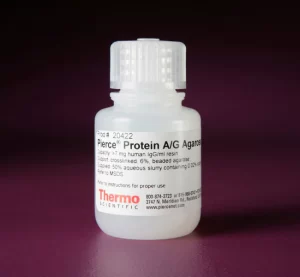
Thermo Scientific™ Pierce™ Protein A/G Agarose X
$2,300.00 Add to cart View Product DetailsThermo Scientific™ Pierce Protein A/G Agarose is a versatile, high-performance affinity resin for antibody purification that is available as bottled agarose beads, pre-packed spin columns, chromatography cartridges and complete IgG purification kits.
Pierce Protein A/G Agarose binds nearly all isotypes and mammalian species of IgG from serum, ascites fluid, cell culture supernantant and other antibody samples, thereby enabling effective antibody purification. Because the immobilized Protein A/G combines the immunoglobulin-binding domains of both Protein A and Protein G, the resin is effective for affinity purification of IgG antibodies from a broad range mammalian host species.
Pierce Protein A/G Agarose consists of purified Protein A/G recombinant fusion protein that has been covalently immobilized onto high-quality crosslinked 6% beaded agarose (CL-6B). This premiere variety of the resin provides the most versatile combination of chromatographic features for high yield and high purity purification of whole IgG from mammalian serum samples. The agarose beads have physical and chemical properties suitable for many affinity purification systems. Accordingly, Pierce Protein A/G Agarose is offered in several convenient package formats, including bottled resin slurries, three sizes of spin columns, complete purification kits, two sizes of FPLC-ready chromatography cartridges, and 96-well filter plates.
Highlights:
- Protein A/G – immobilized recombinant fusion protein of the antibody-binding domains of Protein A and Protein G enables polyclonal IgG purification from nearly any mammalian species
- Agarose resin – support is crosslinked 6% beaded agarose (CL-6B), the most popular resin for protein affinity purification methods
- Inert and stable – superior manufacturing method immobilizes Protein A/G by charge-free, leach-resistant covalent bonds, resulting in low nonspecific binding and enabling multiple uses without decline in yield
- Standard capacity – Pierce Protein A/G Agarose has a normal load of immobilized Protein A/G, providing a binding capacity greater than 7mg human IgG/mL resin
- Multiple formats – choose from bottled resin slurries, centrifuge-ready columns, complete purification kits and two sizes of FPLC-ready chromatography cartridges
Properties of crosslinked 6% beaded agarose (CL-6B):
- Support pH Stability: 2 to 14 (short term); 3 to 13 (long term)
- Average Particle Size: 45 to 165 microns
- Exclusion Limit: 10,000 to 4,000,000 daltons
- Maximum Volumetric Flow Rate: approx. 1mL/minute (for 1cm diameter column)
- Maximum Linear Velocity: 30cm per hour
- Maximum Pressure: less than 25psi (1.5 bar), defined as the maximum pressure drop across a column that the resin can withstand (Note: The indicated gauge pressure of a liquid chromatography apparatus may be measuring the total system pressure rather than the pressure drop across the column.)
Available Formats:
- Resin Slurries: 3mL and 15mL bottles
- Spin Columns: 0.2mL (microcentrifuge), 1mL, 5mL columns
- Purification Kits: complete kits in all three column sizes
- Chromatography Cartridges: compatible with automated liquid chromatography systems and with syringe processing
- Bulk and Custom: let us know your needs for bulk Pierce Protein A/G Agarose
Includes:
Purification kits contain Protein A/G Spin Columns, binding buffer, elution buffer and neutralization buffer
-

Thermo Scientific™ Pierce™ Protein A/G Plus Agarose X
$660.10 Add to cart View Product DetailsHighlights:
- Protein A/G – immobilized recombinant fusion protein of the antibody-binding domains of Protein A and Protein G enables polyclonal IgG purification from nearly any mammalian species
- Agarose resin – support is crosslinked 6% beaded agarose (CL-6B), the most popular resin for protein affinity purification methods
- Inert and stable – superior manufacturing method immobilizes Protein A/G by charge-free, leach-resistant covalent bonds, resulting in low nonspecific binding and enabling multiple uses without decline in yield
- High capacity – “Plus” variety of Pierce Protein A/G Agarose has a very dense load of immobilized Protein A/G, providing a binding capacity greater than 50mg human IgG/mL resin
Properties of crosslinked 6% beaded agarose (CL-6B):
- Support pH Stability: 2 to 14 (short term); 3 to 13 (long term)
- Average Particle Size: 45 to 165 microns
- Exclusion Limit: 10,000 to 4,000,000 daltons
- Maximum Volumetric Flow Rate: approx. 1mL/minute (for 1cm diameter column)
- Maximum Linear Velocity: 30cm per hour
- Maximum Pressure: less than 25psi (1.5 bar), defined as the maximum pressure drop across a column that the resin can withstand (Note: The indicated gauge pressure of a liquid chromatography apparatus may be measuring the total system pressure rather than the pressure drop across the column.)
-
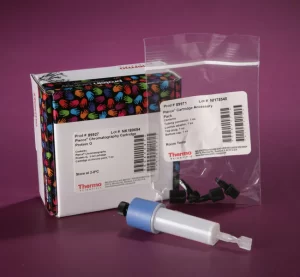
Thermo Scientific™ Pierce™ Protein G Chromatography Cartridges, 1 mL
$742.90 Add to cart View Product DetailsThermo Scientific™ Pierce Protein G Agarose is a versatile, high-performance affinity resin for antibody purification that is available as bottled agarose beads, pre-packed spin columns, 96-well filter plates and complete IgG purification kits.
Pierce Protein G Agarose is effective for affinity purification of IgG from serum and other fluids of many mammalian species. Protein G is especially well suited for use with mouse antibodies (including IgG1) in addition to most IgG isotypes from human, goat and sheep samples.
Pierce Protein G Agarose consists of recombinant Protein G that has been covalently immobilized onto high-quality crosslinked 6% beaded agarose (CL-6B). This premiere variety of the affinity resin provides the most versatile combination of chromatographic features for high yield and high purity purification of whole IgG from mammalian serum samples. The agarose beads have physical and chemical properties suitable for many affinity purification systems. Accordingly, Pierce Protein G Agarose is offered in several convenient package formats, including bottled resin slurries, three sizes of spin columns, complete purification kits, two sizes of FPLC-ready chromatography cartridges, and 96-well filter plates.
Highlights:
- Protein G – immobilized Protein G is ideal for polyclonal IgG purification from mouse, human, cow, goat and sheep serum, including human IgG3 and mouse IgG1 isotypes
- Agarose resin – support is crosslinked 6% beaded agarose (CL-6B), the most popular resin for protein affinity purification methods
- Inert and stable – superior manufacturing method immobilizes Protein G by charge-free, leach-resistant covalent bonds, resulting in low nonspecific binding and enabling multiple uses without decline in yield
- Standard capacity – Pierce Protein G Agarose has a normal load of immobilized Protein G, providing a binding capacity of 11 to 15mg human IgG/mL resin
- Multiple formats – choose from bottled resin slurries, centrifuge-ready columns, complete purification kits, two sizes of FPLC-ready chromatography cartridges, and 96-well filter plates
Properties of crosslinked 6% beaded agarose (CL-6B):
- Support pH Stability: 2 to 14 (short term); 3 to 13 (long term)
- Average Particle Size: 45 to 165 microns
- Exclusion Limit: 10,000 to 4,000,000 daltons
- Maximum Volumetric Flow Rate: approx. 1mL/minute (for 1cm diameter column)
- Maximum Linear Velocity: 30cm per hour
- Maximum Pressure: less than 25psi (1.5 bar), defined as the maximum pressure drop across a column that the resin can withstand (Note: The indicated gauge pressure of a liquid chromatography apparatus may be measuring the total system pressure rather than the pressure drop across the column.)
Available Formats:
- Resin Slurries: 2mL, 10mL, 25mL bottles
- Spin Columns: 0.2mL (microcentrifuge), 1mL, 5mL columns
- Purification Kits: complete kits in all three column sizes
- Chromatography Cartridges: compatible with automated liquid chromatography systems and with syringe processing
- 96-well Spin Plates: pre-dispensed 96-well filter plates, compatible with centrifugation and vacuum manifold systems for manual or automated purification. The plates enable fast, consistent well-to-well and plate-to-plate reproducibility for small-scale, high-throughput separations.
- Bulk and Custom: let us know your needs for bulk Pierce Protein G Agarose
Includes:
Purification kits contain Protein G Spin Columns, binding buffer, elution buffer and neutralization buffer
-

Thermo Scientific™ Pierce™ Protein G Chromatography Cartridges, 1 mL
$366.85 Add to cart View Product DetailsThermo Scientific™ Pierce Protein G Agarose is a versatile, high-performance affinity resin for antibody purification that is available as bottled agarose beads, pre-packed spin columns, 96-well filter plates and complete IgG purification kits.
Pierce Protein G Agarose is effective for affinity purification of IgG from serum and other fluids of many mammalian species. Protein G is especially well suited for use with mouse antibodies (including IgG1) in addition to most IgG isotypes from human, goat and sheep samples.
Pierce Protein G Agarose consists of recombinant Protein G that has been covalently immobilized onto high-quality crosslinked 6% beaded agarose (CL-6B). This premiere variety of the affinity resin provides the most versatile combination of chromatographic features for high yield and high purity purification of whole IgG from mammalian serum samples. The agarose beads have physical and chemical properties suitable for many affinity purification systems. Accordingly, Pierce Protein G Agarose is offered in several convenient package formats, including bottled resin slurries, three sizes of spin columns, complete purification kits, two sizes of FPLC-ready chromatography cartridges, and 96-well filter plates.
Highlights:
- Protein G – immobilized Protein G is ideal for polyclonal IgG purification from mouse, human, cow, goat and sheep serum, including human IgG3 and mouse IgG1 isotypes
- Agarose resin – support is crosslinked 6% beaded agarose (CL-6B), the most popular resin for protein affinity purification methods
- Inert and stable – superior manufacturing method immobilizes Protein G by charge-free, leach-resistant covalent bonds, resulting in low nonspecific binding and enabling multiple uses without decline in yield
- Standard capacity – Pierce Protein G Agarose has a normal load of immobilized Protein G, providing a binding capacity of 11 to 15mg human IgG/mL resin
- Multiple formats – choose from bottled resin slurries, centrifuge-ready columns, complete purification kits, two sizes of FPLC-ready chromatography cartridges, and 96-well filter plates
Properties of crosslinked 6% beaded agarose (CL-6B):
- Support pH Stability: 2 to 14 (short term); 3 to 13 (long term)
- Average Particle Size: 45 to 165 microns
- Exclusion Limit: 10,000 to 4,000,000 daltons
- Maximum Volumetric Flow Rate: approx. 1mL/minute (for 1cm diameter column)
- Maximum Linear Velocity: 30cm per hour
- Maximum Pressure: less than 25psi (1.5 bar), defined as the maximum pressure drop across a column that the resin can withstand (Note: The indicated gauge pressure of a liquid chromatography apparatus may be measuring the total system pressure rather than the pressure drop across the column.)
Available Formats:
- Resin Slurries: 2mL, 10mL, 25mL bottles
- Spin Columns: 0.2mL (microcentrifuge), 1mL, 5mL columns
- Purification Kits: complete kits in all three column sizes
- Chromatography Cartridges: compatible with automated liquid chromatography systems and with syringe processing
- 96-well Spin Plates: pre-dispensed 96-well filter plates, compatible with centrifugation and vacuum manifold systems for manual or automated purification. The plates enable fast, consistent well-to-well and plate-to-plate reproducibility for small-scale, high-throughput separations.
- Bulk and Custom: let us know your needs for bulk Pierce Protein G Agarose
Includes:
Purification kits contain Protein G Spin Columns, binding buffer, elution buffer and neutralization buffer
-
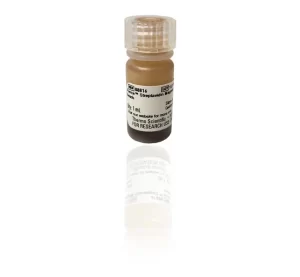
Thermo Scientific™ Pierce™ Streptavidin Magnetic Beads
$458.85 Add to cart View Product DetailsAccelerate throughput for automated magnetic purification of biotinylated molecules with Thermo Scientific™ Pierce Streptavidin Magnetic Beads.
Magnetic streptavidin beads enable affinity purification of biotin-labeled target molecules without columns or centrifugation. The platform provides a fast and convenient method for manual or automated immunoprecipitation, protein interaction analysis, DNA-protein pull-down, and purification involving biotin-labeled proteins and nucleic acids. The iron oxide superparamagnetic particles offer superior performance (high capacity and low nonspecific binding) compared with other commercial magnetic beads. Biotinylated molecules are simply added to the streptavidin-coated magnetic beads for binding. Pierce Streptavidin Magnetic Beads are validated and optimized for use with high-throughput magnetic platforms, such as the Thermo Scientific KingFisher™ 96 and KingFisher Flex Instruments, but the beads also enable premium performance for simple benchtop applications using an appropriate magnetic stand.
Highlights:
- High-performance beads – non-aggregating, pre-blocked, iron oxide, superparamagnetic microparticles provide exceptional uniformity for automated HTS and manual applications alike
- Stable immobilization chemistry – streptavidin is immobilized using leach-resistant chemistry
- High capacity – superior quality beads with high binding capacity provide rapid and efficient biomolecule purification from complex samples
- Low non-specific binding – stable, pre-blocked beads provide clean purification products (e.g., antigen eluted in IP with biotinylated antibody) that are compatible with mass spectrometry analysis and other downstream analyses
- Superior performance – nearly three times higher binding capacity than typical beads from other suppliers, allowing the use of smaller amounts per experiment
Properties of Streptavidin Magnetic Beads:
- Composition: ion oxide particles covalently coated with a monolayer of streptavidin protein
- Magnetization: superparamagnetic (no magnetic memory)
- Bead size: 1μm (nominal mean diameter)
- Density: 2g/cm3
- Concentration: 10mg beads per milliliter of slurry in 0.05% sodium azide
- Binding capacity: approx. 55μg biotinylated rabbit IgG per mg of beads; approx. 3500pmol biotinylated fluorescein per milliliter of beads
- RNase: these bead solutions are NOT tested and certified to be RNAse-free
Requires:
Thermo Scientific KingFisher 96 or KingFisher Flex Instrument or other magnetic separator device
Recommended for:
Immunoprecipitate antigens (using biotinylated antibodies) from a wide variety of sources; Co-immunoprecipitate interaction complexes using biotinylated antibodies; Capture protein-protein interactions in pull-down assays using biotinylated bait proteins; Isolate biotin-labeled DNA-protein complexes from cell or tissue extracts; Capture single-stranded biotinylated DNA oligos; Isolate biotinylated PCR products
-
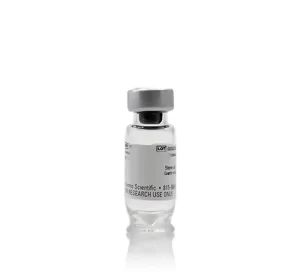
Thermo Scientific™ Pierce™ Streptavidin, Maleimide-Activated
$285.20 Add to cart View Product DetailsThermo Scientific™ Pierce Streptavidin and Conjugates include purified recombinant streptavidin biotin-binding protein, plus standard SA-HRP, SA-AP and fluorescent conjugates for biotin-based assays.
These purified and conjugated forms of recombinant streptavidin protein enable detection of biotinylated antibodies and other probes in a variety of standard assay methods, including Western blotting, ELISA, immunohistochemistry and fluorescence imaging. Purified streptavidin and the streptavidin-HRP conjugates (peroxidase-conjugated streptavidin) are supplied lyophilized in phosphate-based buffers for immediate reconstitution with water. Alkaline Phosphatase conjugates are supplied as a liquid in a Tris-based buffer.
Highlights:
- Recombinant streptavidin – high-quality protein, 53kDa, pI equals 6.8 to 7.5
- Pure protein and enzyme conjugates – choose pure, unconjugated protein for biotin blocking and controls; enzyme conjugates for substrate-based detection
- Fluorophore conjugates – standard fluorescent forms (fluorescein, rhodamine, etc.) for traditional immunofluorescence techniques
- Activated preparations – choose a maleimide-activated or hydrazide-activated form to prepare a custom streptavidin conjugate with sulfhydryl- or carbohydrate-containing molecule
-
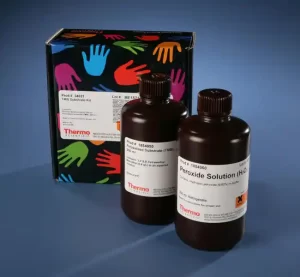
Thermo Scientific™ Pierce™ TMB Substrate Kit SKU: 34021
$240.35 Add to cart View Product DetailsThermo Scientific™ Pierce TMB ELISA Substrates detect horseradish peroxidase (HRP) activity, yielding a blue color (Amax = 370nm and 652nm) that changes to yellow (Amax = 450nm) upon addition of a sulfuric or phosphoric acid stop solution.
nTMB (3,3′,5,5′ tetramethylbenzidine) is a chromagen that yields a blue color when oxidized with hydrogen peroxide (catalyzed by HRP) with major absorbances at 370 and 652nm. The color then changes to yellow (measured at 450nm) upon addition of sulfuric or phosphoric acid to stop the reaction. TMB is very sensitive and more quickly oxidized than other HRP substrates, resulting in faster color development. Unlike other commercially available substrates, these products contain no DMF or DMSO. There are three formulations that differ primarily in their sensitivities. Slow TMB is intermediate in sensitivity, ideal for kinetic readings. The sensitivity of the Turbo TMB compares to that of OPD used at approximately 1mg/mL. Ultra TMB-ELISA produces the highest signal-to-noise ratio and sensitivity in the picogram range.nnHighlights:n
-
- n
- Ready-to-use solutions
n
-
- No hydrogen peroxide required
n
-
- No filtering required
n
-
- Noncarcinogenic
n
-
- Various sensitivities to suit any assay
n
n1-Step TMB Substratesn
-
- n
- Ready-to-use, one-component substrates
n
-
- Do not require hydrogen peroxide
n
-
- Noncarcinogenic
n
-
- Do not contain DMF or DMSO
n
-
- Available in three formulations that vary by sensitivity
n
nTMB Substrate Kitn
-
- n
- More sensitive than OPD in endpoint ELISAs
n
-
- Easy to use
n
-
- Provides results in seconds
n
nIncludes:nnTMB Substrate Kit (PI-34021): Peroxidase substrate, 200mL; Peroxide solution, 200mL
-
-
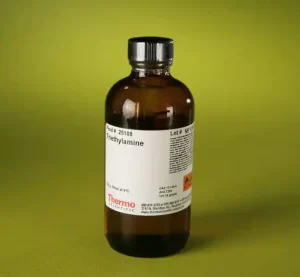
Thermo Scientific™ Pierce™ Triethylamine (TEA), Sequencing Grade
$204.70 Add to cart View Product DetailsThermo Scientific™ Pierce Triethylamine (TEA) is a high-purity solvent that can be used in certain HPLC protocols, such as weak anion exchange to resolve certain tryptic peptides on a reverse-phase column.
nTriethylamine is an ion-pairing reagent that alters selectivity in reverse-phase HPLC separations. By pairing with peptides, it effectively sharpens peaks, resulting in improved peak resolution.
-
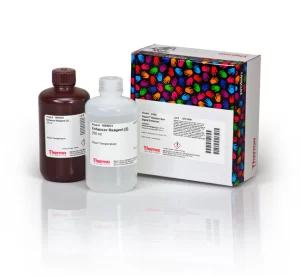
Thermo Scientific™ Pierce™ Western Blot Signal Enhancer
$231.15 Add to cart View Product DetailsThermo Scientific™ Pierce Western Blot Signal Enhancer is a two-reagent system for conditioning protein blots after transfer to greatly enhance the effectiveness of primary antibodies and intensify the final detection signal in Western blot experiments.
The Pierce Western Blot Signal Enhancer membrane treatment procedure is very simple, takes only 15 minutes and can be added to nearly any existing Western blotting protocol. The result is an increase in the intensity of target protein bands on the Western blot or detection of target proteins at levels that were previously not possible. The product is effective for signal intensification with both chemiluminescent and chromogenic substrates, especially with nitrocellulose membranes.
Highlights:
- Increases protein detection – most protein targets show a three- to 10-fold increase in signal intensity, enabling much less protein to be detected with the same substrate and method
- Improves antibody binding – the membrane-treatment reagent exposes and conditions target proteins so that specific antibodies can bind more effectively
- Works for nearly any protein – signal enhancement has been demonstrated with targets such as IL-6, p53, NFkB, BRCA1 and EGF
- Effective with any substrate – enhances both chemiluminescent (ECL) and colorimetric detection for Western blots
- Compatible with any membrane – enhances signal on nitrocellulose and PVDF membrane, regardless of pore size (enhancement is less pronounced with PVDF)
- Fast, 15-minute protocol – optimized for a combination of simplicity, speed and signal enhancement for most proteins
- Ready-to-use – no formulating or diluting necessary, and the reagents are stable for storage at room temperature
Includes:
Enhancer Reagent 1, 250mL; Enhancer Reagent 2, 250mL
-
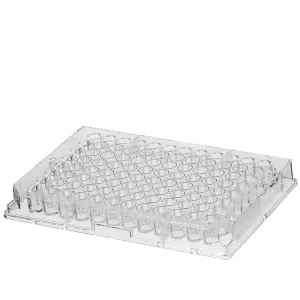
Thermo Scientific™ Plates and Modules with Affinity Binding Surfaces
$1,023.81 Add to cart View Product DetailsHelp reduce variability in molecular orientation with Thermo Scientific™ Plates and Modules with Affinity Binding Surfaces.
Affinity Capture Surfaces (Passive Streptavidin and Immobilizer Streptavidin, Nickel Chelate and Glutathione, BioBind)
-
- Highly specific binding
n
-
- Reduced variability in molecular orientation
n
-
- Immobilizer surfaces improve signal to noise ratios
n
-
- Streptavidin biotin interaction can be exploited to immobilize a wide range of biomolecules
n
-
-
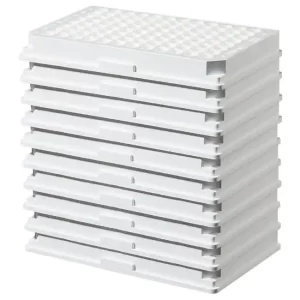
Thermo Scientific™ Plates and Modules with Affinity Binding Surfaces
$1,036.44 Add to cart View Product DetailsHelp reduce variability in molecular orientation with Thermo Scientific™ Plates and Modules with Affinity Binding Surfaces.
Affinity Capture Surfaces (Passive Streptavidin and Immobilizer Streptavidin, Nickel Chelate and Glutathione, BioBind)
-
- Highly specific binding
n
-
- Reduced variability in molecular orientation
n
-
- Immobilizer surfaces improve signal to noise ratios
n
-
- Streptavidin biotin interaction can be exploited to immobilize a wide range of biomolecules
n
-
-
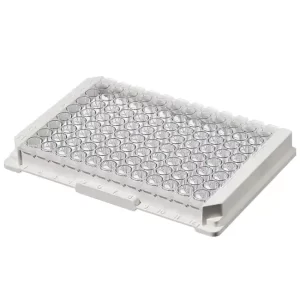
Thermo Scientific™ Plates and Modules with Affinity Binding Surfaces
$1,092.86 Add to cart View Product DetailsHelp reduce variability in molecular orientation with Thermo Scientific™ Plates and Modules with Affinity Binding Surfaces.
Affinity Capture Surfaces (Passive Streptavidin and Immobilizer Streptavidin, Nickel Chelate and Glutathione, BioBind)
-
- Highly specific binding
n
-
- Reduced variability in molecular orientation
n
-
- Immobilizer surfaces improve signal to noise ratios
n
-
- Streptavidin biotin interaction can be exploited to immobilize a wide range of biomolecules
n
-
-

Thermo Scientific™ Plates and Modules with Covalent Binding Surfaces
$1,032.18 Add to cart View Product DetailsReduce the amount of reagents used in the lab with Thermo Scientific™ Plates and Modules with Covalent Binding Surfaces. Covalent Surfaces (Thermo Scientific™ CovaLink™ and Immobilizer Amino)
-
- Minimal leaching
n
-
- Withstands vigorous washing
n
-
- Coating with lower amounts of reagent may be possible
n
-
- Control of orientation
n
-
-
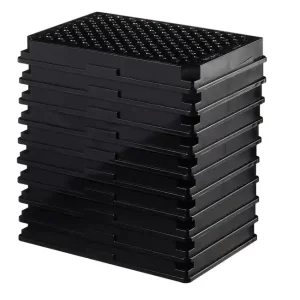
Thermo Scientific™ Plates and Modules with Covalent Binding Surfaces
$1,129.52 Add to cart View Product DetailsReduce the amount of reagents used in the lab with Thermo Scientific™ Plates and Modules with Covalent Binding Surfaces.
Covalent Surfaces (Thermo Scientific™ CovaLink™ and Immobilizer Amino)
-
- Minimal leaching
n
-
- Withstands vigorous washing
n
-
- Coating with lower amounts of reagent may be possible
n
-
- Control of orientation
n
-
-
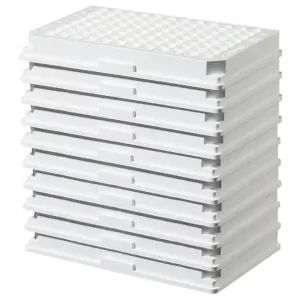
Thermo Scientific™ Plates and Modules with Covalent Binding Surfaces
$1,137.96 Add to cart View Product DetailsReduce the amount of reagents used in the lab with Thermo Scientific™ Plates and Modules with Covalent Binding Surfaces.
Covalent Surfaces (Thermo Scientific™ CovaLink™ and Immobilizer Amino)
-
- Minimal leaching
n
-
- Withstands vigorous washing
n
-
- Coating with lower amounts of reagent may be possible
n
-
- Control of orientation
n
-
-
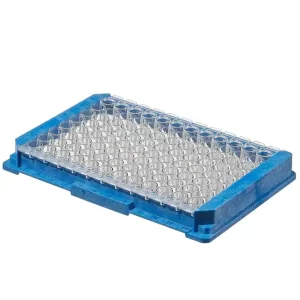
Thermo Scientific™ Plates and Modules with Covalent Binding Surfaces
$937.18 Add to cart View Product DetailsReduce the amount of reagents used in the lab with Thermo Scientific™ Plates and Modules with Covalent Binding Surfaces.
Covalent Surfaces (Thermo Scientific™ CovaLink™ and Immobilizer Amino)
-
- Minimal leaching
n
-
- Withstands vigorous washing
n
-
- Coating with lower amounts of reagent may be possible
n
-
- Control of orientation
n
-
-

Thermo Scientific™ Plates and Modules with Covalent Binding Surfaces
$1,092.59 Add to cart View Product DetailsReduce the amount of reagents used in the lab with Thermo Scientific™ Plates and Modules with Covalent Binding Surfaces.nn nnCovalent Surfaces (Thermo Scientific™ CovaLink™ and Immobilizer Amino)n
-
- Minimal leaching
n
-
- Withstands vigorous washing
n
-
- Coating with lower amounts of reagent may be possible
n
-
- Control of orientation
n
Immobilizer is a trademark of Exiqon A/S, Vedbaek, Denmark. The product is produced under license from Exiqon A/S and covered by EP 08 20483 and foreign application and patents.
-
-
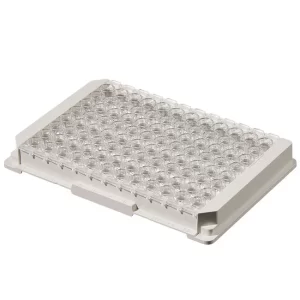
Thermo Scientific™ Plates and Modules with Covalent Binding Surfaces
$1,092.59 Add to cart View Product DetailsReduce the amount of reagents used in the lab with Thermo Scientific™ Plates and Modules with Covalent Binding Surfaces.
Covalent Surfaces (Thermo Scientific™ CovaLink™ and Immobilizer Amino)
- Minimal leaching
- Withstands vigorous washing
- Coating with lower amounts of reagent may be possible
- Control of orientation
Immobilizer is a trademark of Exiqon A/S, Vedbaek, Denmark. The product is produced under license from Exiqon A/S and covered by EP 08 20483 and foreign application and patents.
-
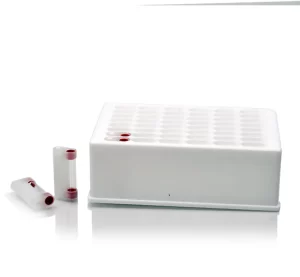
Thermo Scientific™ Rapid Equilibrium Dialysis (RED) Inserts and Plates
$64.40 Add to cart View Product DetailsRapid Equilibrium Dialysis (RED) Devices have been widely adopted as an effective in vitro technique for conducting plasma protein binding (PPB) assays in drug development. This measurement is used to assess the biological availability of drug candidates and guides critical downstream decisions such as drug design, in vivo testing prioritization, and drug-drug interaction evaluation. RED Devices were developed through close collaboration with the pharmaceutical industry, ensuring that they meet the highest standards of accuracy and reliability in equilibrium dialysis testing.
Equilibrium dialysis is commonly used in drug-plasma protein binding (PPB) studies to quantitate the free fraction of drugs in plasma. The binding of drugs to plasma proteins is a critical factor that affects their pharmacokinetics and pharmacodynamics, as only the free fraction of a drug can exert a physiological effect. The Thermo Scientific Pierce Rapid Equilibrium Dialysis (RED) Device is a superior method for conducting this analysis because it delivers accurate and consistent data with shorter preparation and dialysis times.
RED Devices use a size-defined dialysis membrane to quantitate the amount of free (active) drug molecules that are not bound to plasma proteins. They consist of disposable inserts and a base plate with a standard microplate footprint. The inserts are made of two side-by-side chambers separated by a dialysis membrane and are used along with a required base plate or are available as single-use plates with Inserts. Competition RED Devices are also available to enable competitive dialysis experiments with multiple tissue or protein fluid samples.
Features of RED Devices include:
• Ease of use—disposable tubes do not require presoaking, assembly, or specialized equipment
• Rapid dialysis—high surface-to-volume ratio of the membrane enables equilibrium in 2–4 hours
• High-throughput—96-well footprint is suitable for automation
• Multi-sample processing—can be used for 1–48 assays/plate without wasting an entire plate
• Robustness—compartmentalized design eliminates the potential for cross-contamination or leakage
• Reproducibility and accuracy—validated for plasma protein binding assays, producing results consistent with those reported in the literature
• Flexible format—available in pre-inserted disposable polypropylene plates and packs of individual insertsIn addition to plasma protein binding, the device is used for determining drug partitioning between red blood cells and plasma, protein binding of liver microsomes to improve the correlation between in vitro and in vivo intrinsic clearance, drug metabolism and pharmacokinetics (DMPK) assays, and competition between tissue protein binding against plasma proteins.
RED Device Inserts, 8K MWCO
Pierce RED Device Inserts are designed for use with a required base plate for equilibrium dialysis experiments. Each single-use, disposable insert is made of two side-by-side chambers separated by an O-ring-sealed vertical cylinder of dialysis membrane (8K MWCO) validated for minimal nonspecific binding. They are available in packs of 50 or 250 each and are useful for testing a variable number of samples per run.RED Device Base Plates
Pierce RED Device Inserts are used with either the RED Device Reusable Base Plate made of high-grade PTFE (Teflon™) or the RED Device Single-Use Base Plate made of high-density polypropylene. The Single-Use Base Plate is disposable and lightweight, allowing routine automation. Each Base Plate holds up to 48 RED Device Inserts and has a standard 96-well plate footprint with 9 x 9 mm well spacing for compatibility with multichannel pipettors and automated liquid handling systems.RED Device Single-Use Plate with Inserts, 8K or 12K MWCO
The RED Device Single-Use Plate with Inserts is composed of disposable high-density polypropylene and comes preloaded with 48 equilibrium dialysis membrane inserts. Each insert includes two side-by-side chambers separated by an O ring sealed vertical cylinder of dialysis membrane (8K or 12K MWCO). The device is automation-friendly and has a standard 96-well plate footprint with 9 x 9 mm well spacing. The single-use plate is easily disposed of to avoid contamination and cleaning, making it useful when performing PPB assays with radioactive or hazardous materials.Competition RED Device Inserts and Base Plate, 12K MWCO
The Pierce Competition RED Device facilitates the analysis of simultaneous drug interactions and partitioning among multiple tissues to accurately model in vivo drug interactions. The system consists of disposable dialysis tube inserts (12K MWCO) and a reusable base plate made of chemically inert high-grade PTFE, eliminating non-specific binding and risk of contamination. The base plate is divided into different size chambers for positioning 2–8 RED Device Inserts per well, enabling competitive dialysis experiments with 2–15 separate tissue or protein fluid samples. Each Competition RED Insert contains either one or two separate dialysis chambers (each package includes both types).Applications of the Competition RED Devices include:
• ADME-Tox studies: in vitro screening of drug partitioning between plasma and multiple tissues before in vivo studies with animal models
• Determine formulation of drug dosage for in vivo studies
• Drug-drug interaction studies
• Competitive binding and dissociation constant determination for small molecules versus multiple targetsRED Device Insert Removal Tool
This tool enables fast removal of 8 inserts at once.
